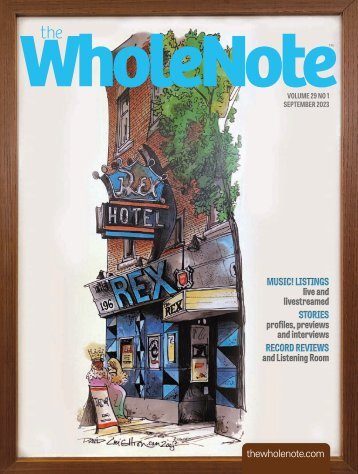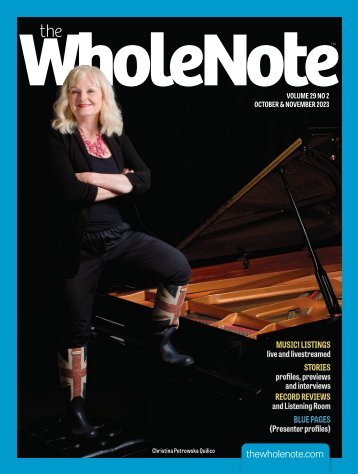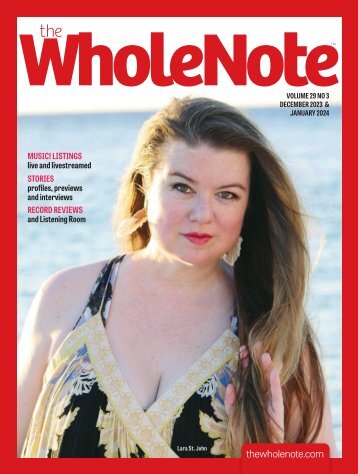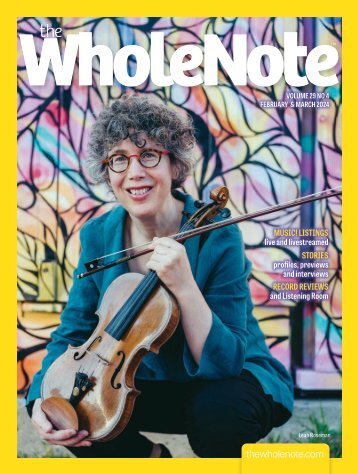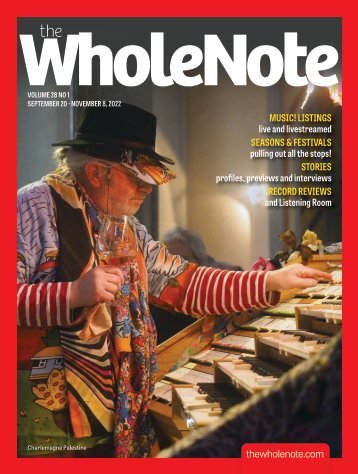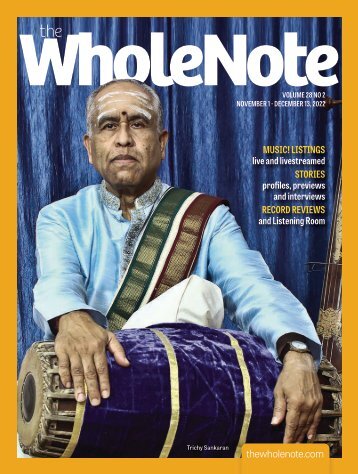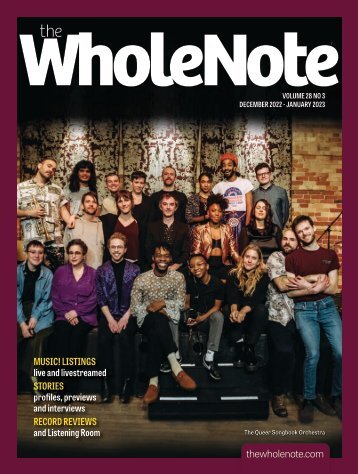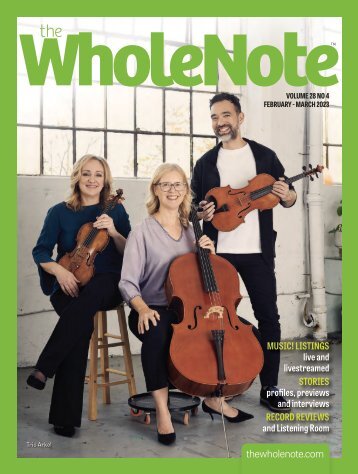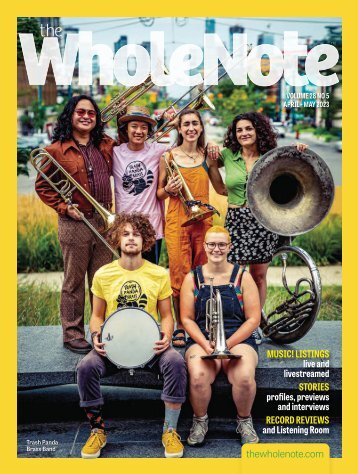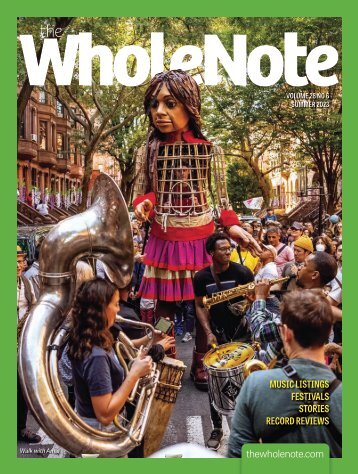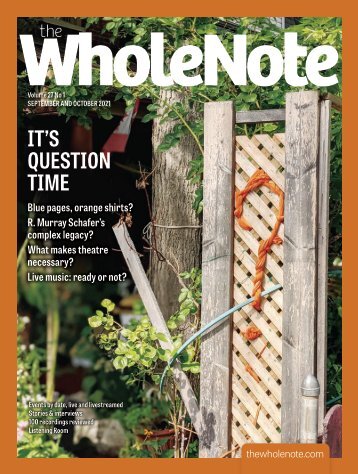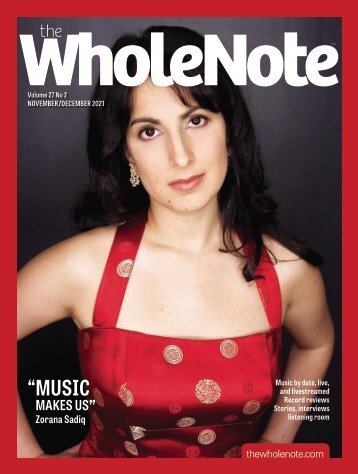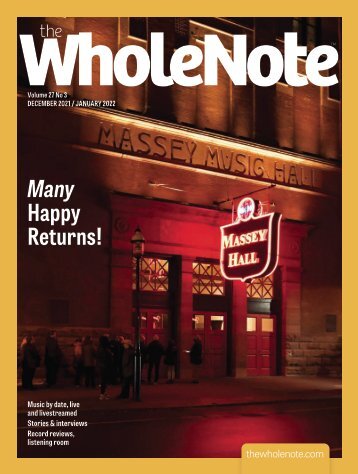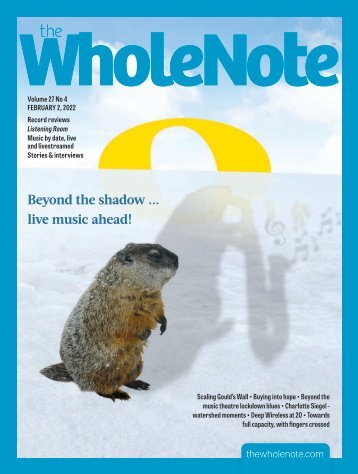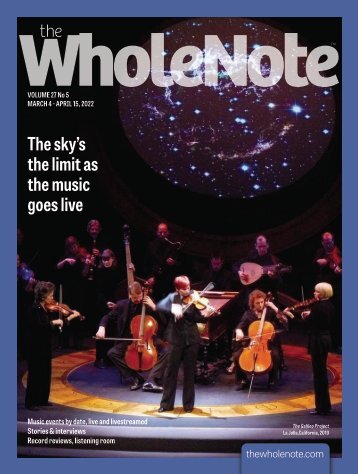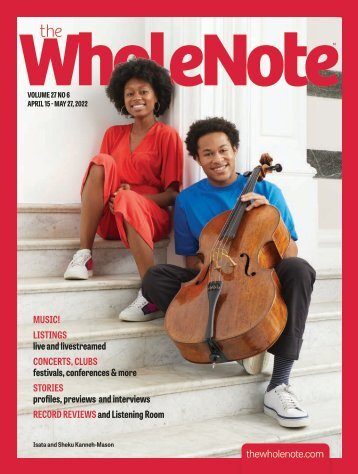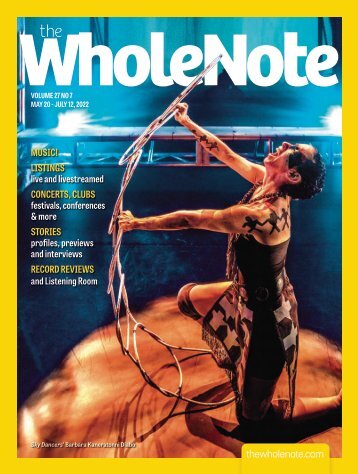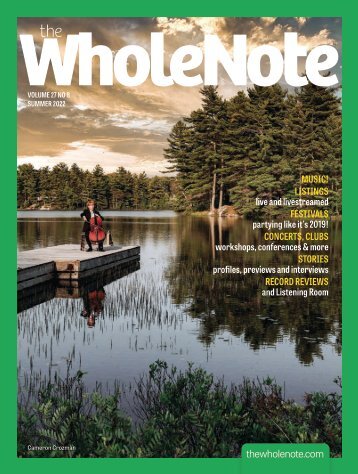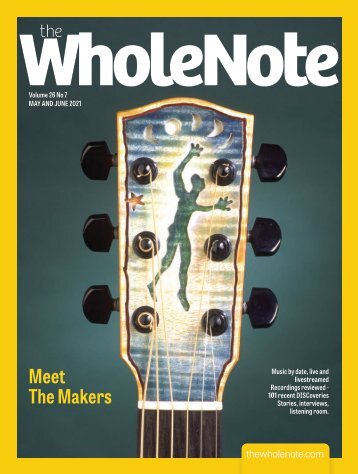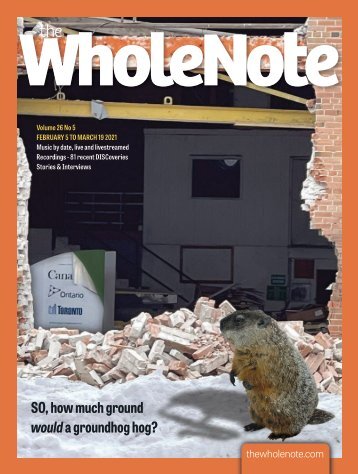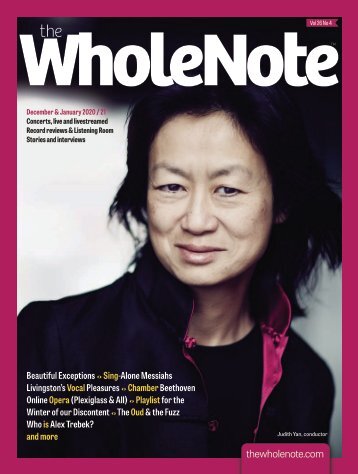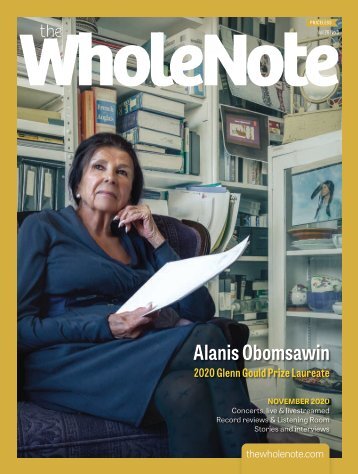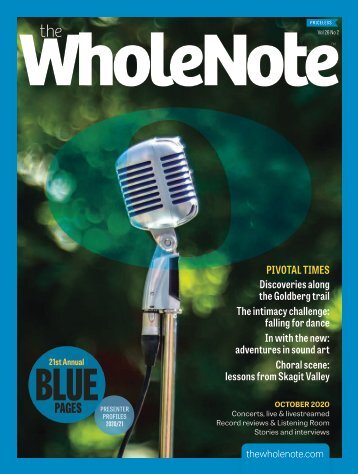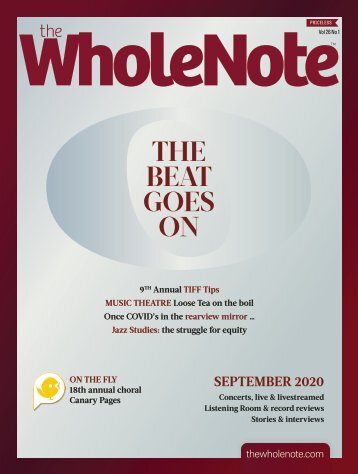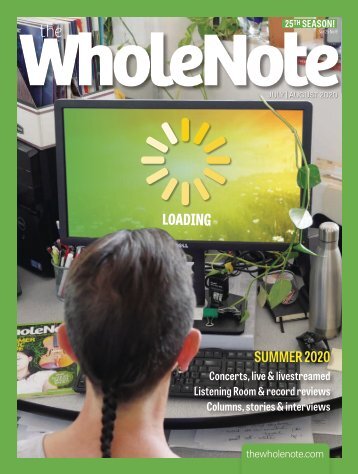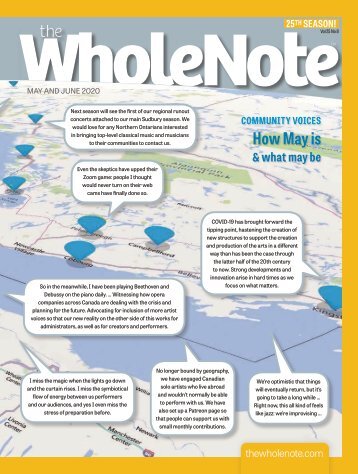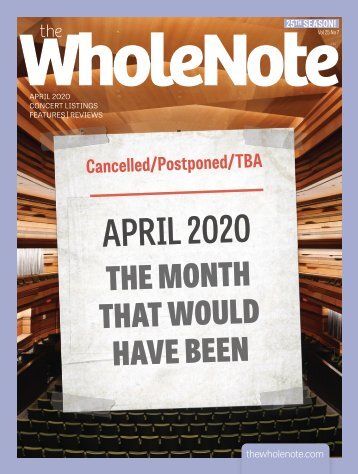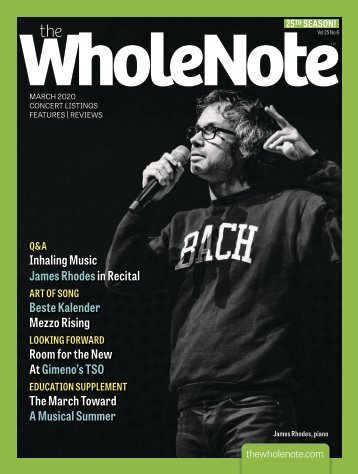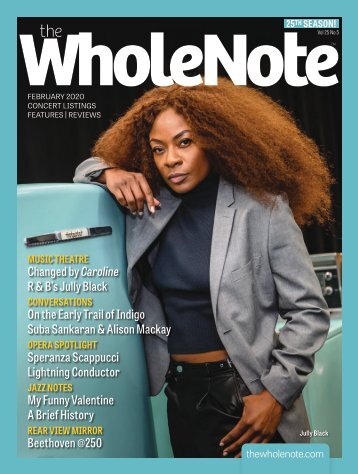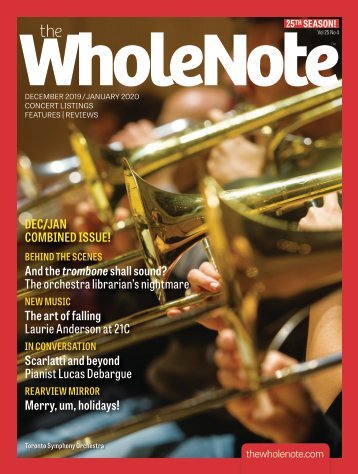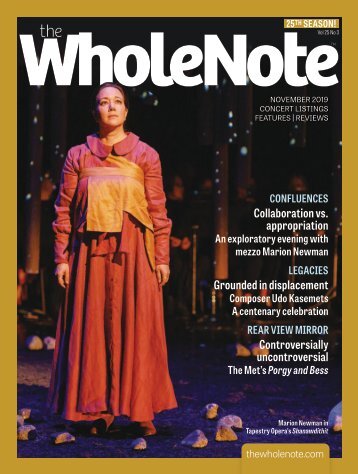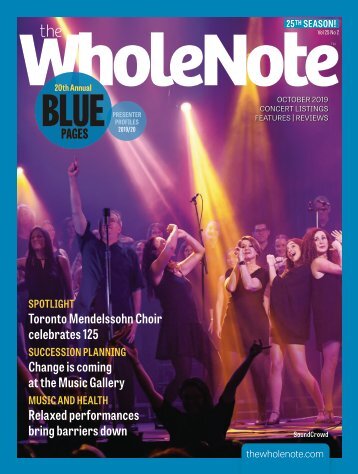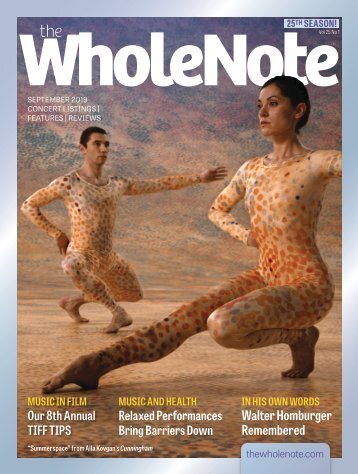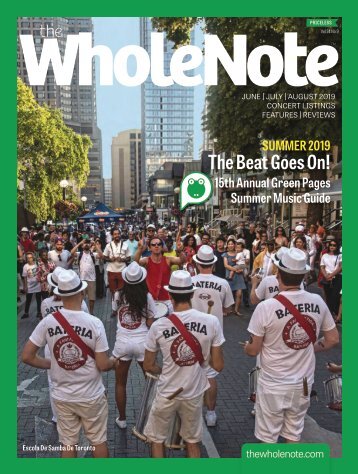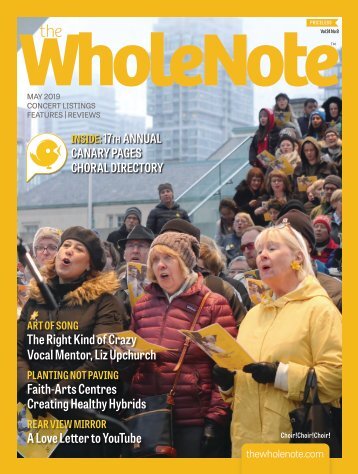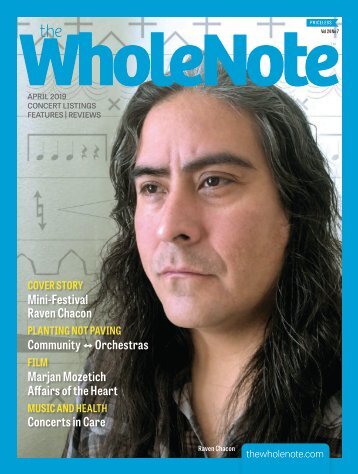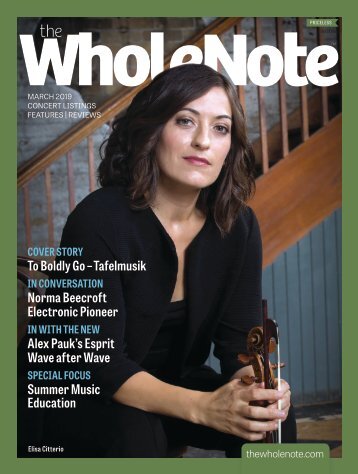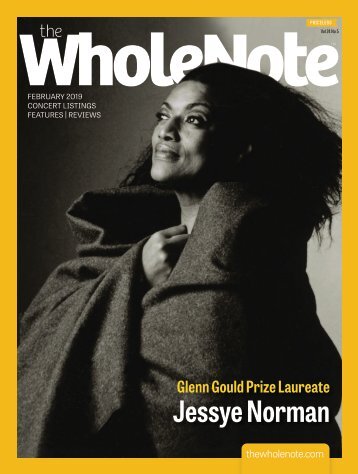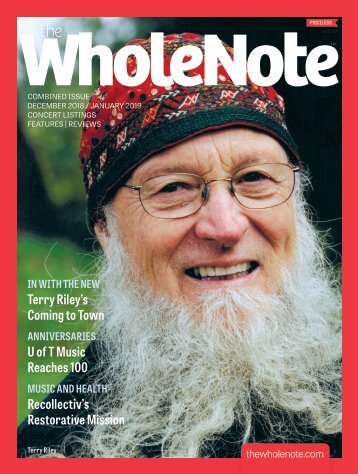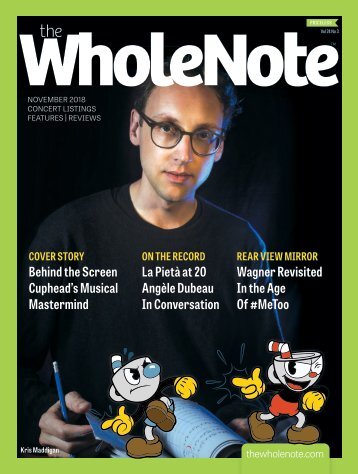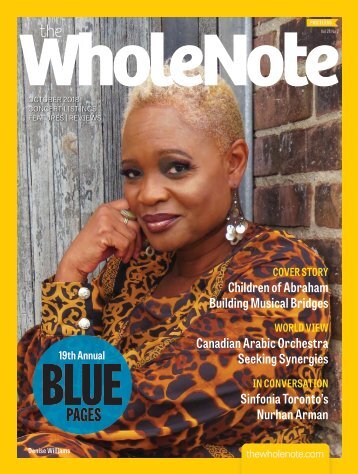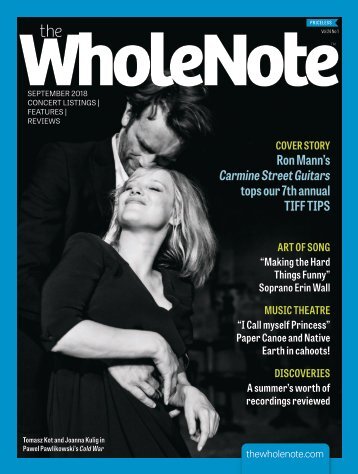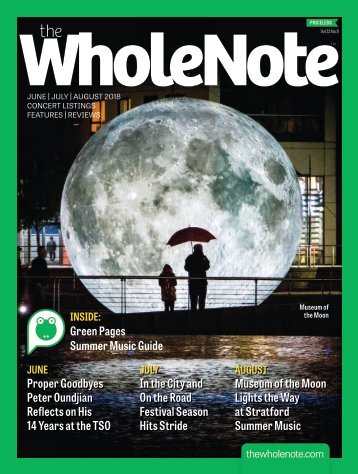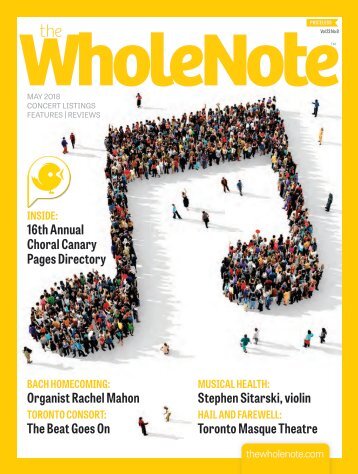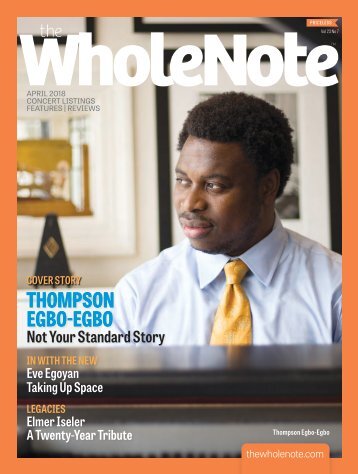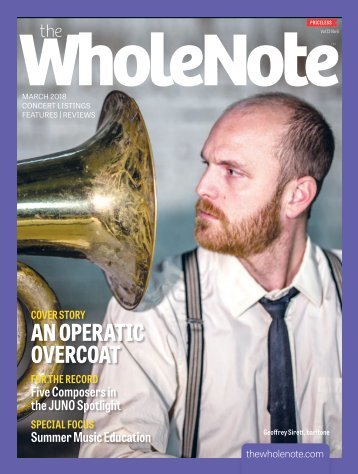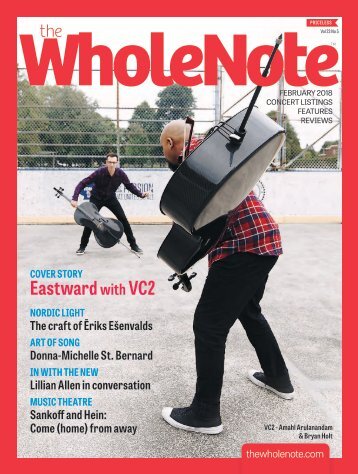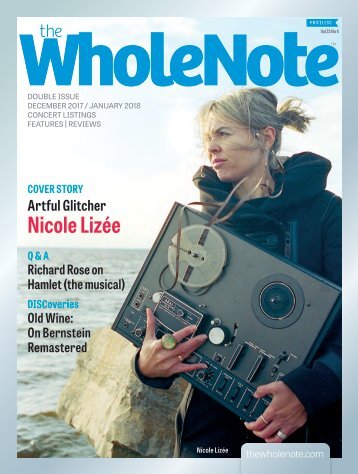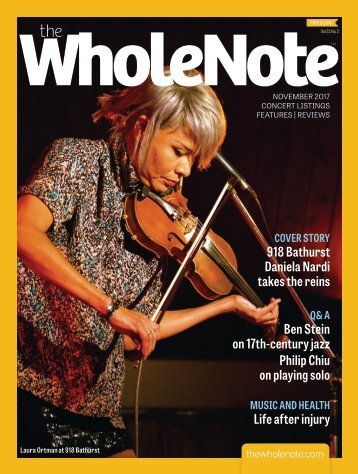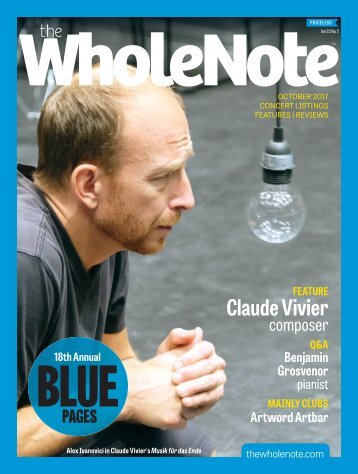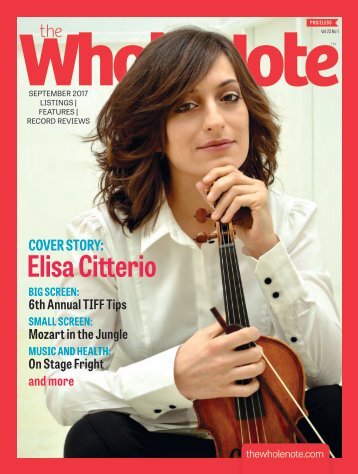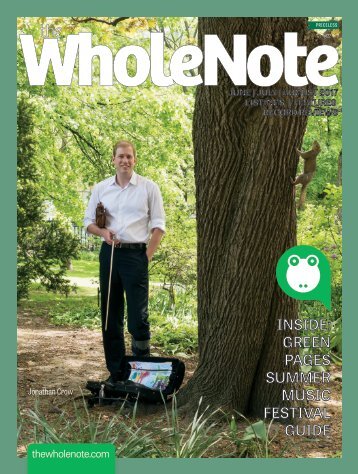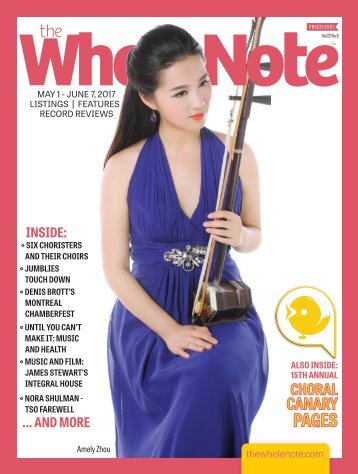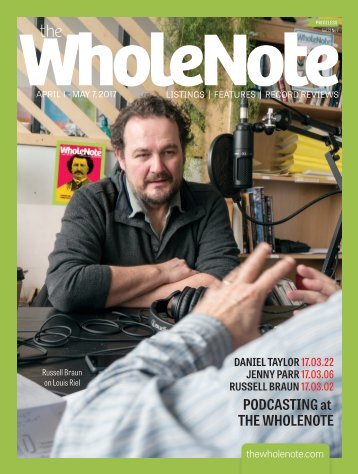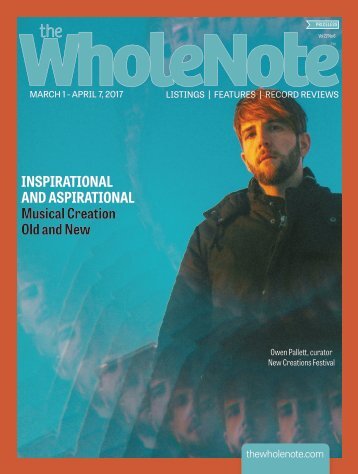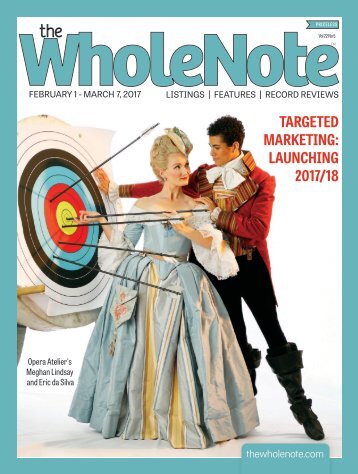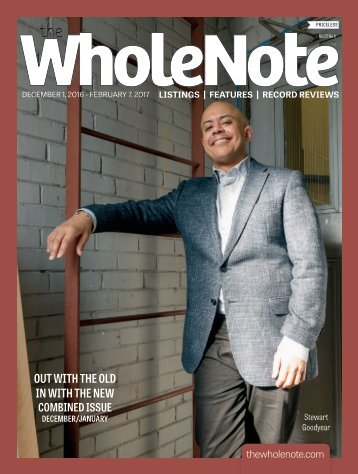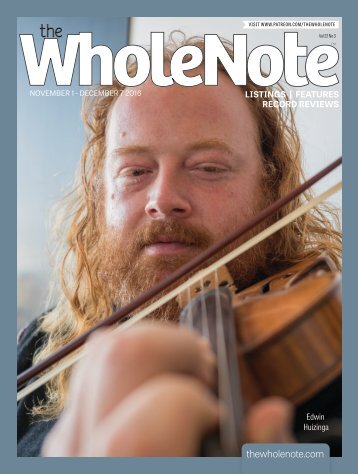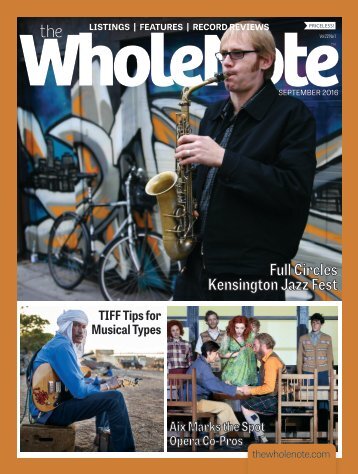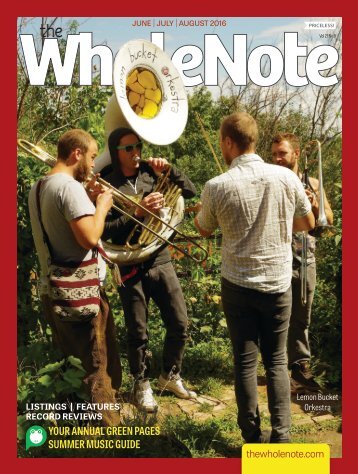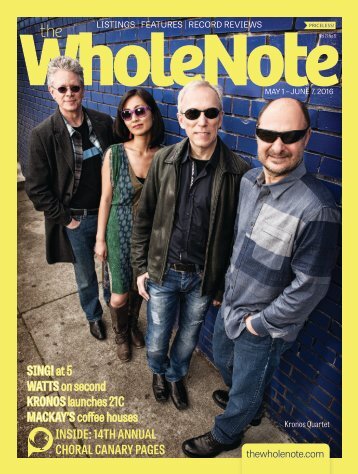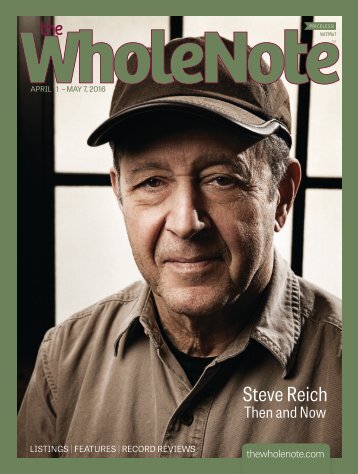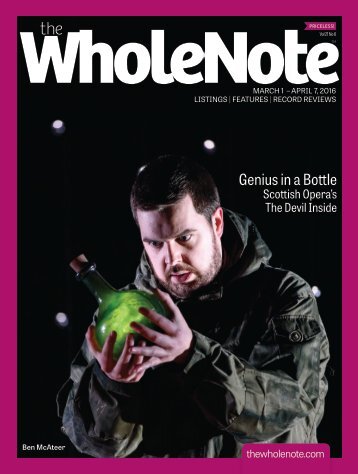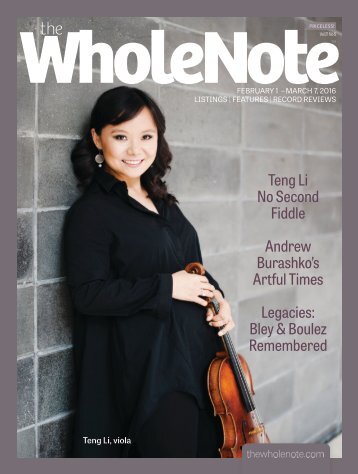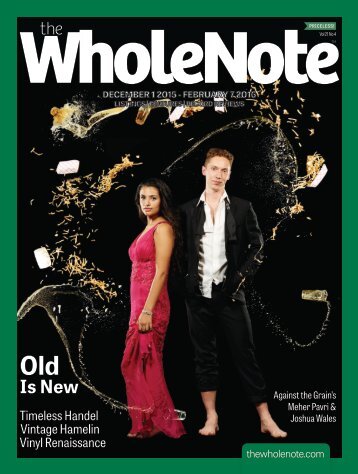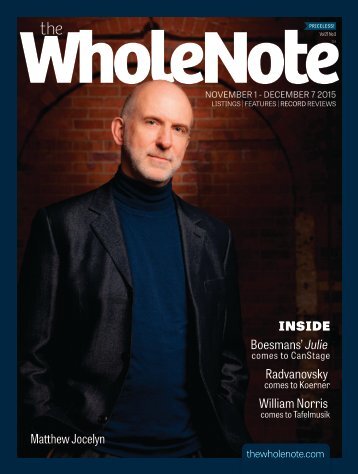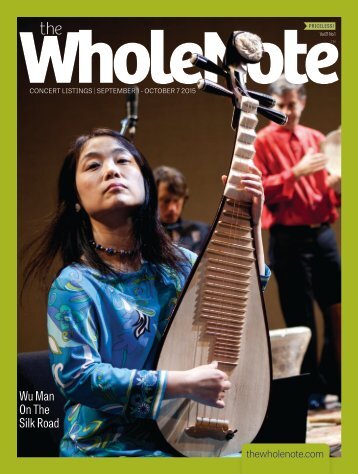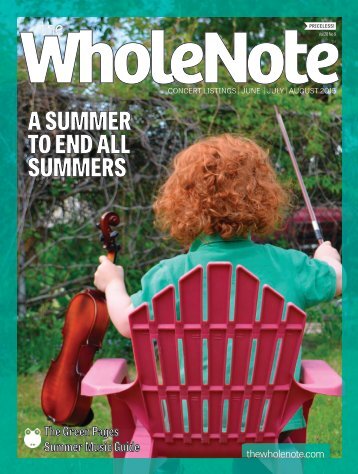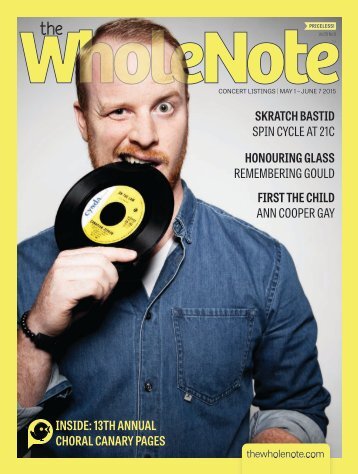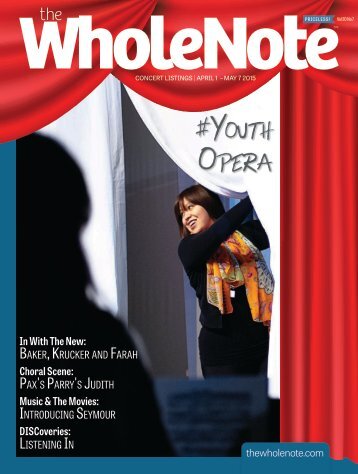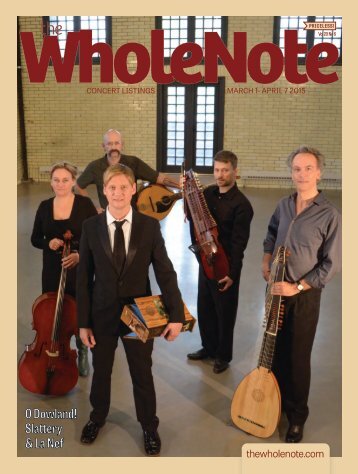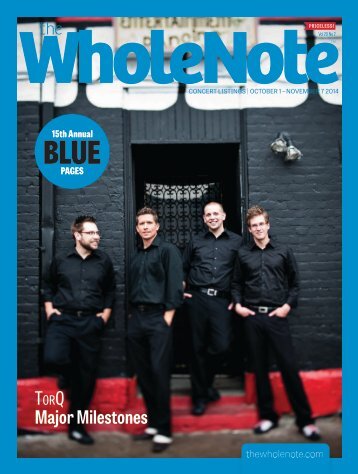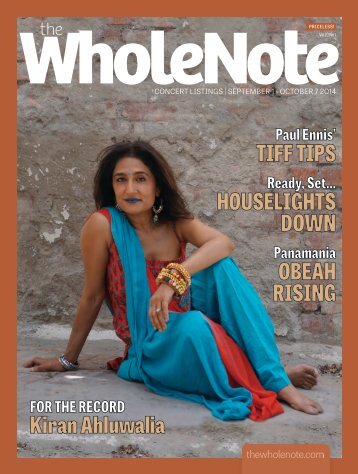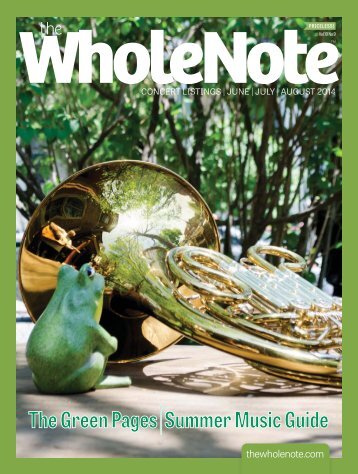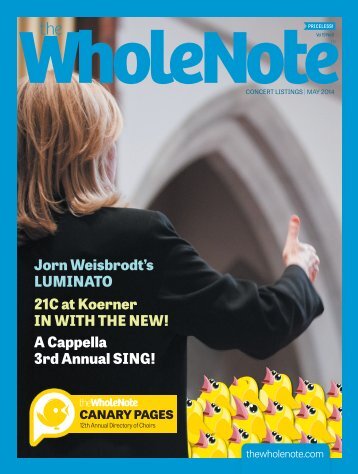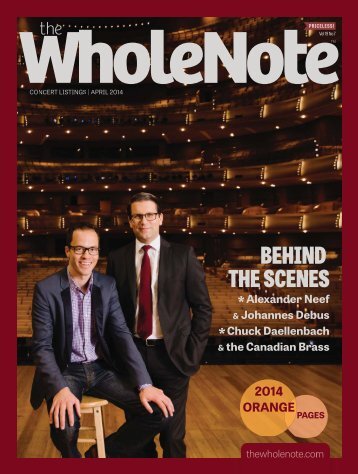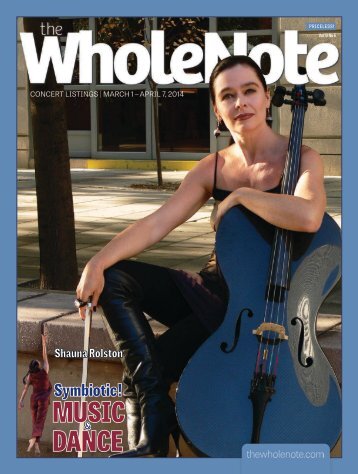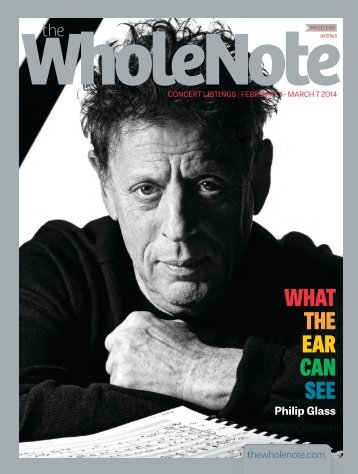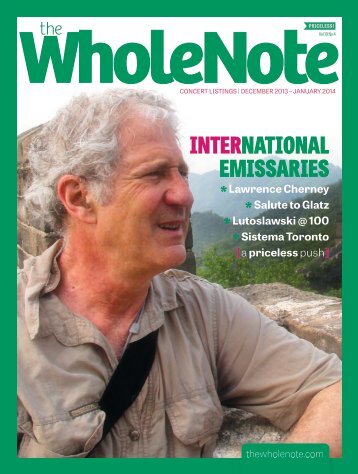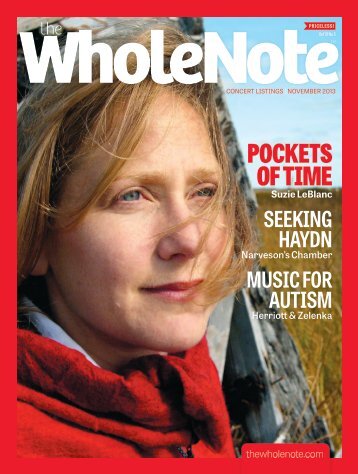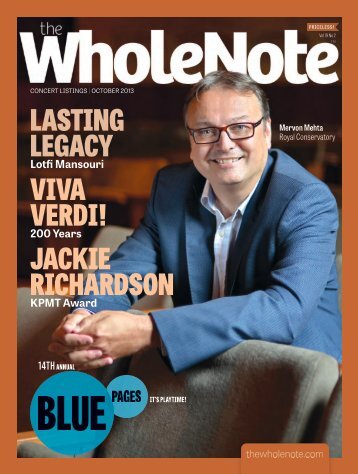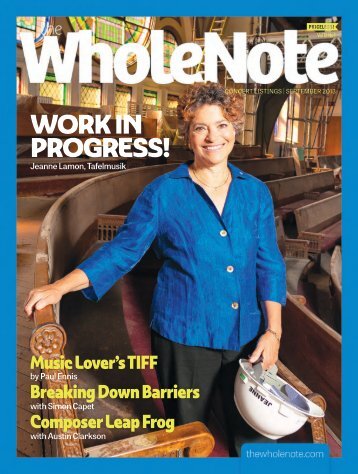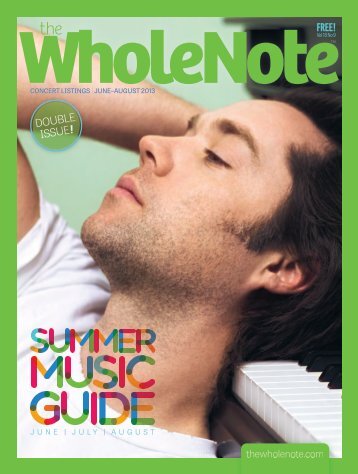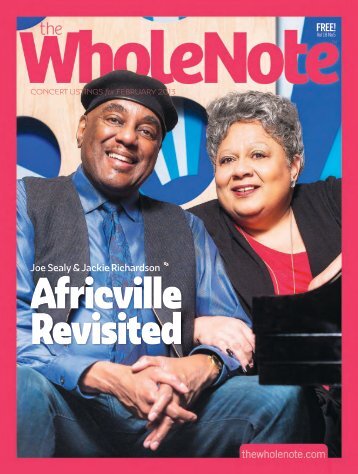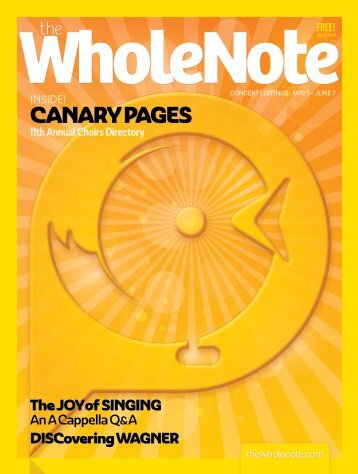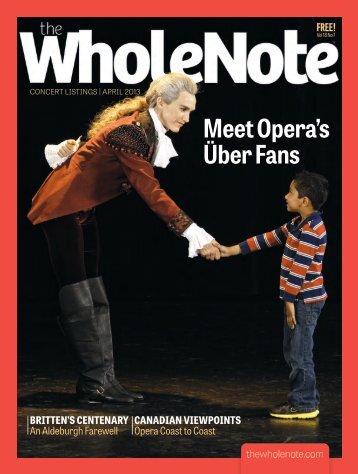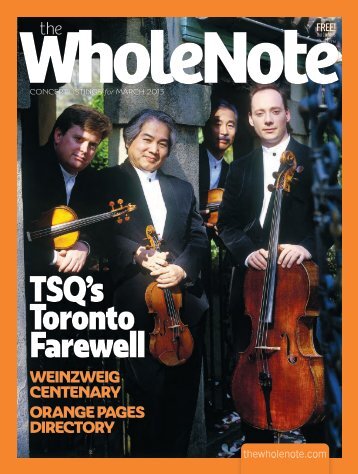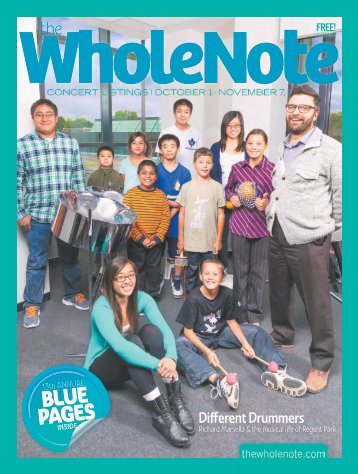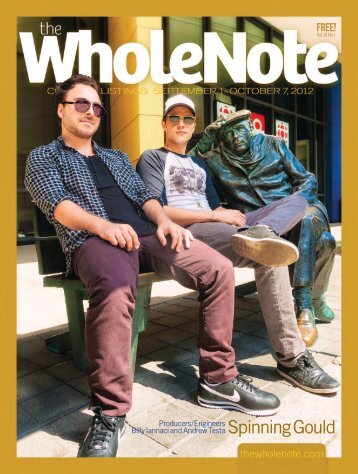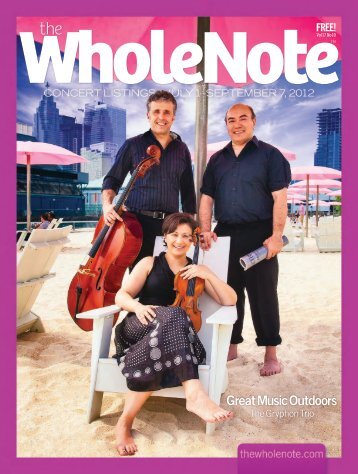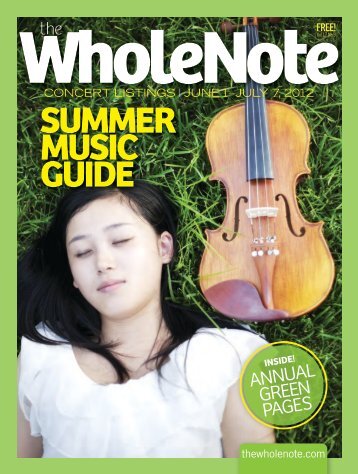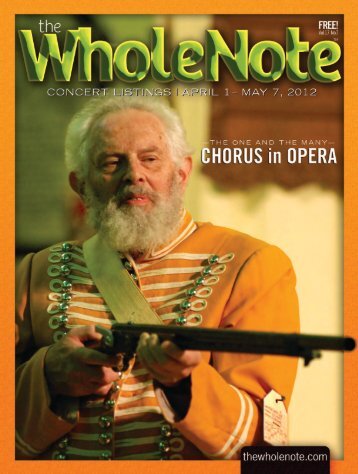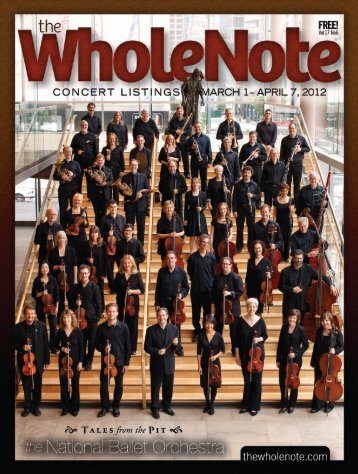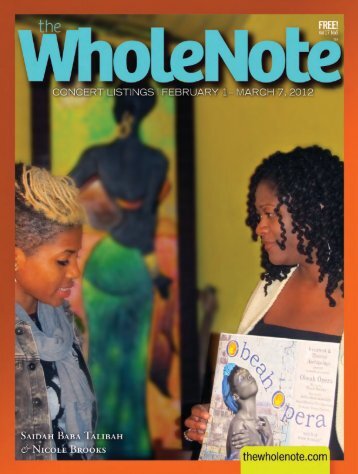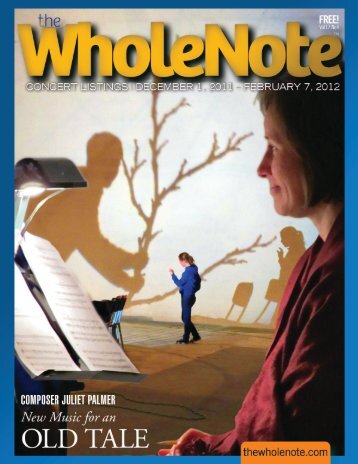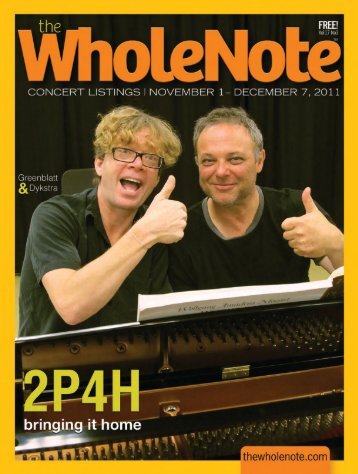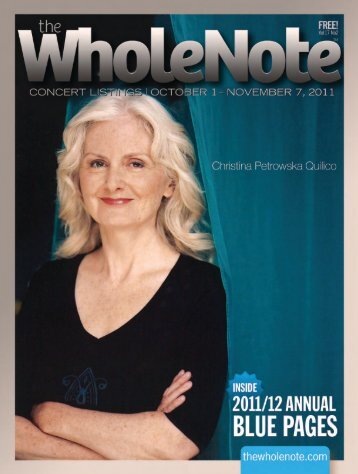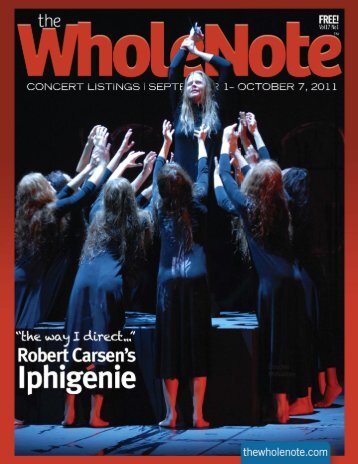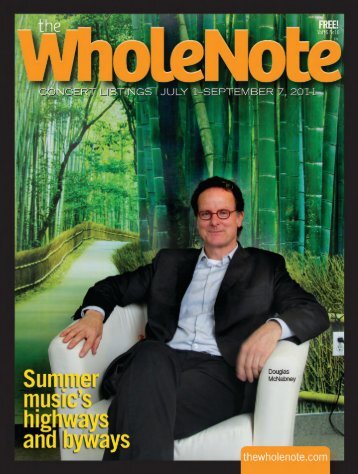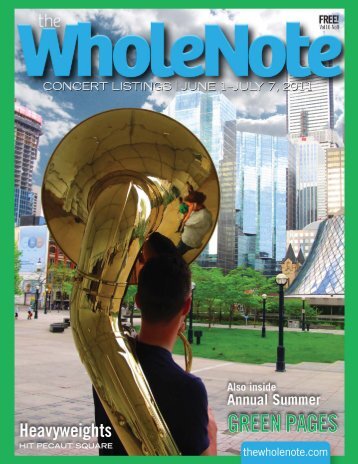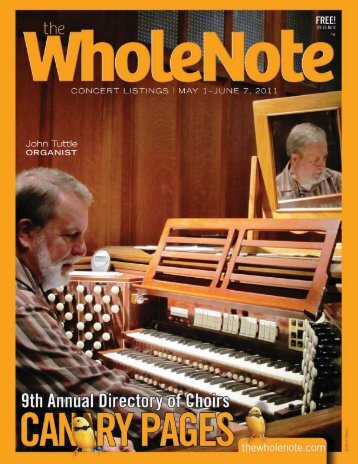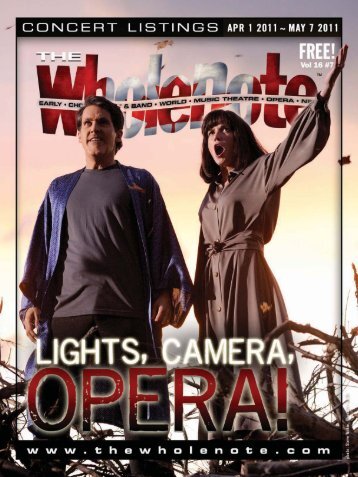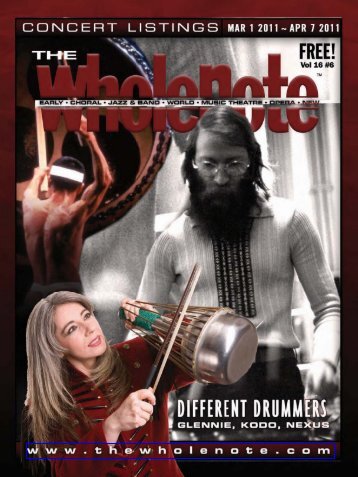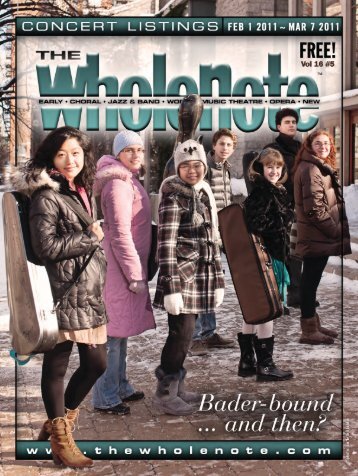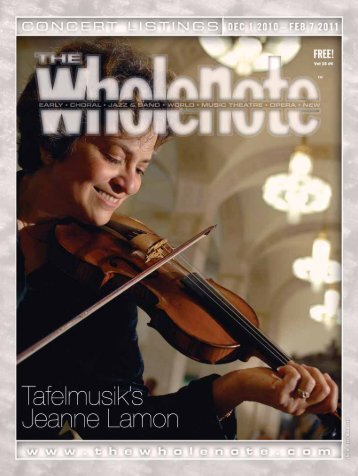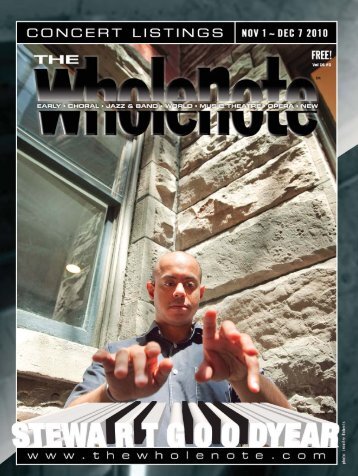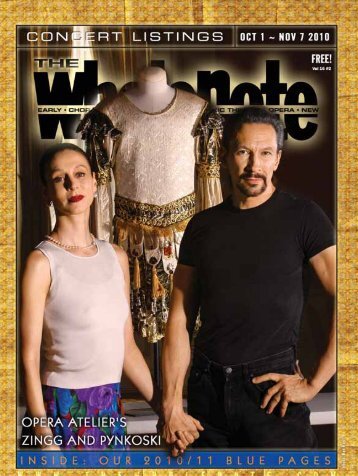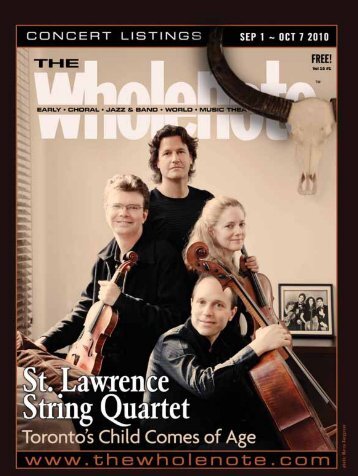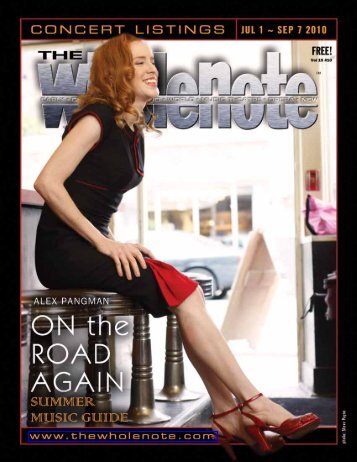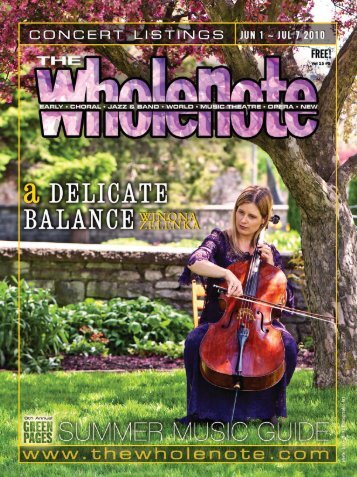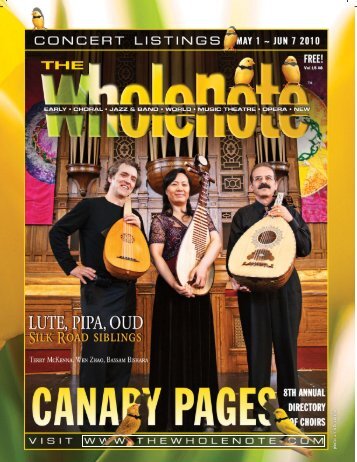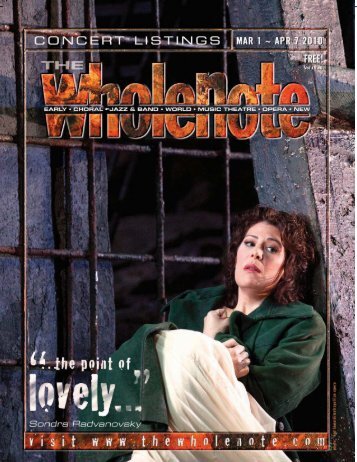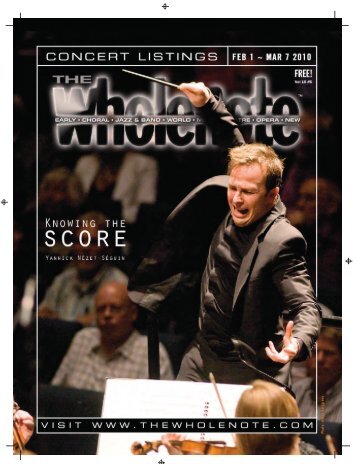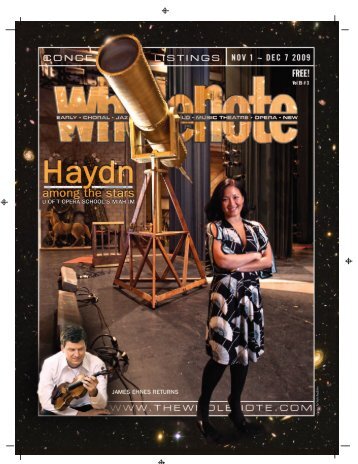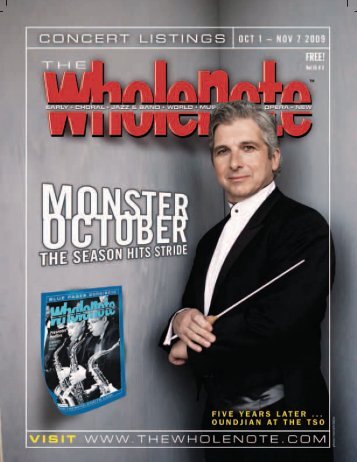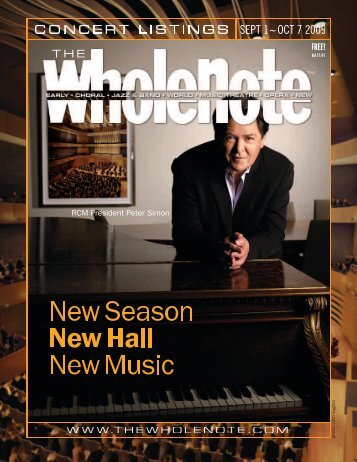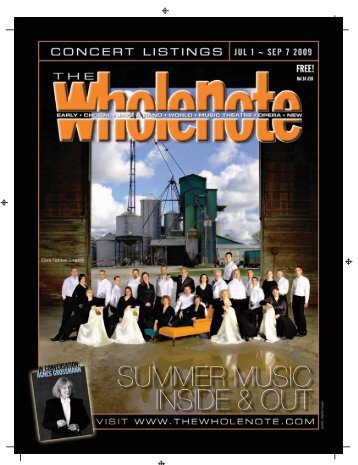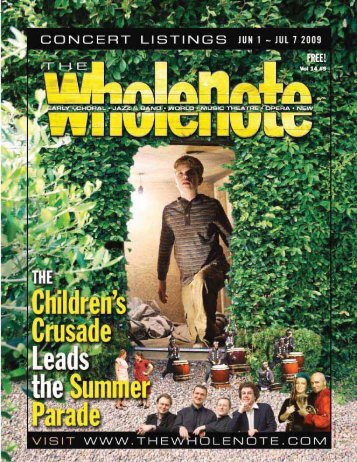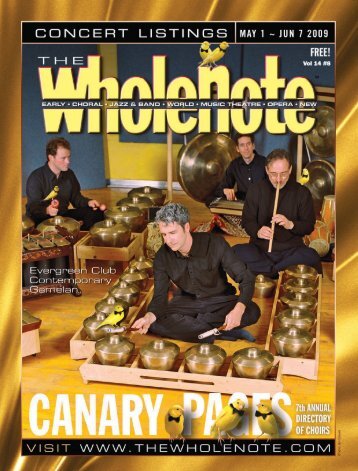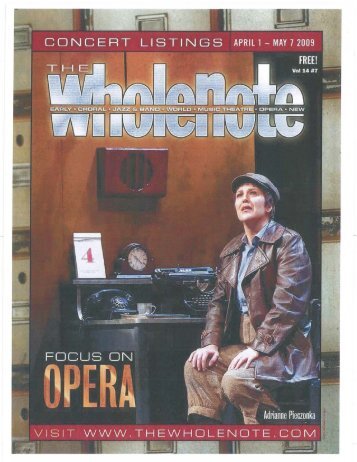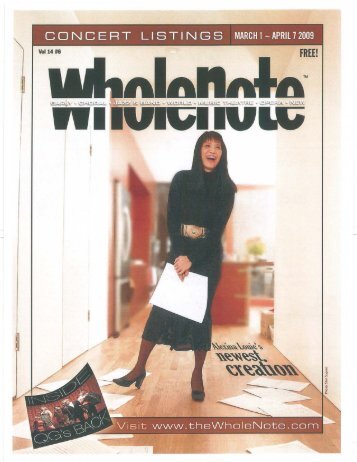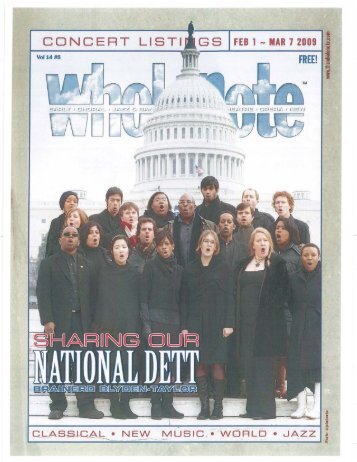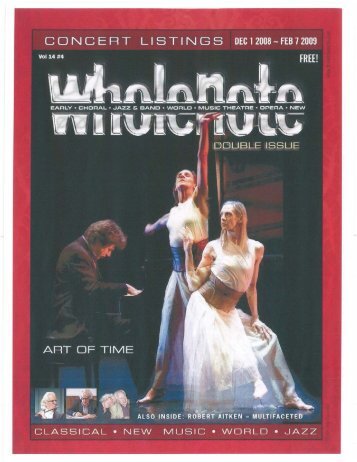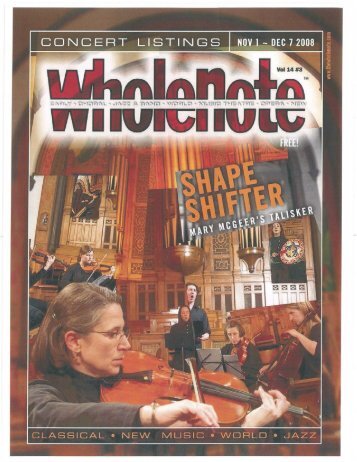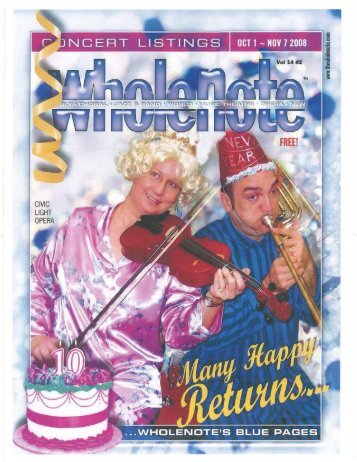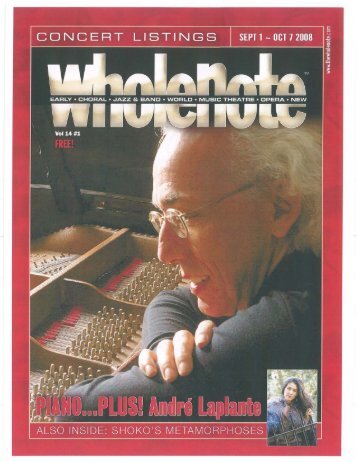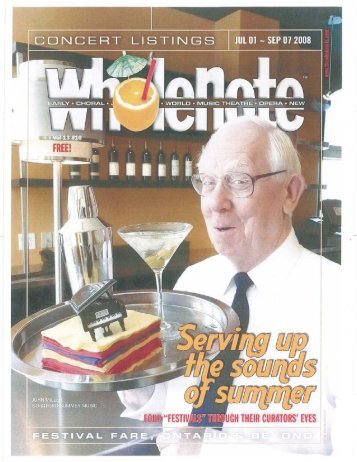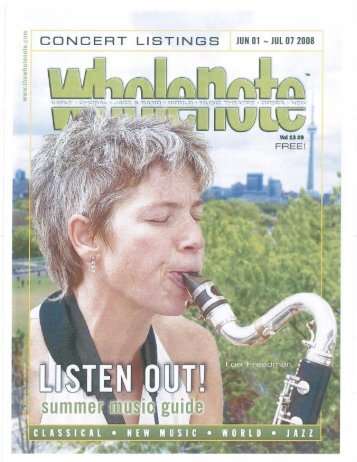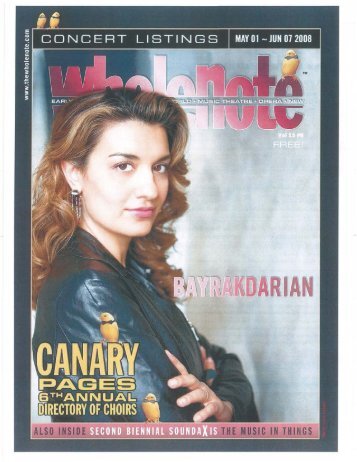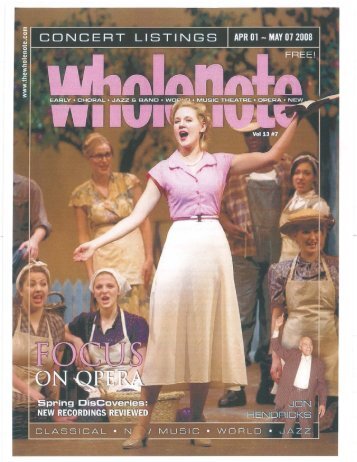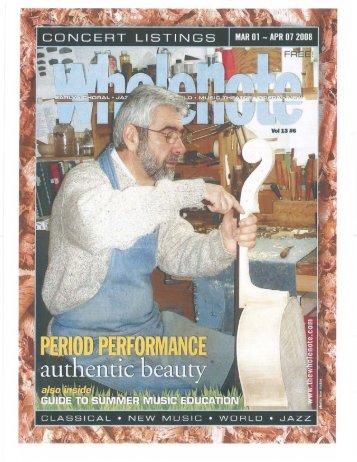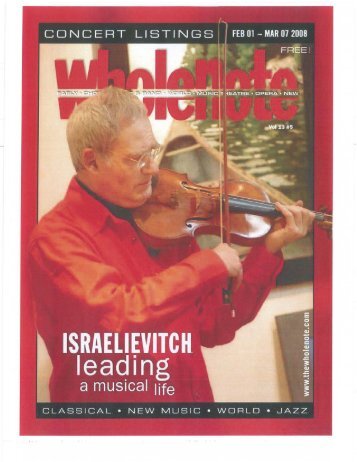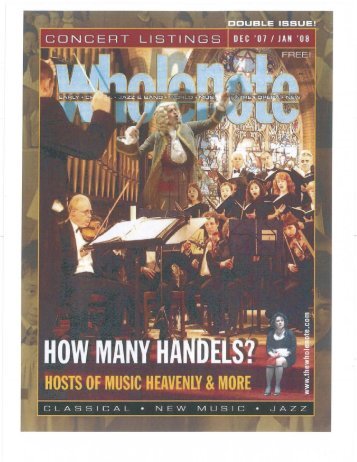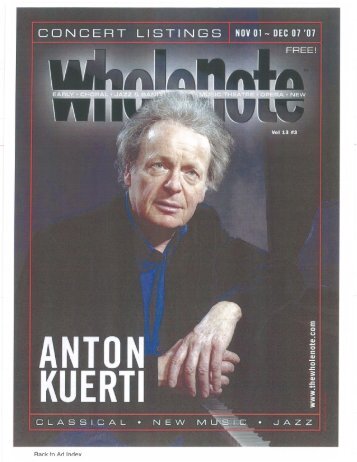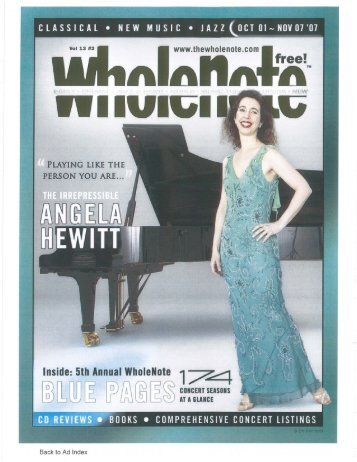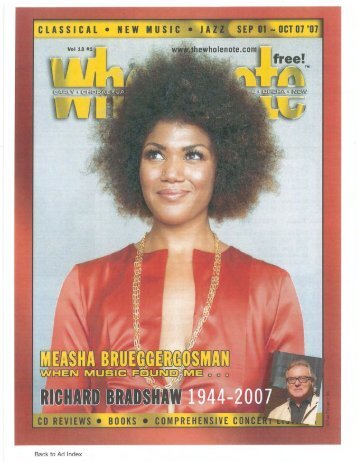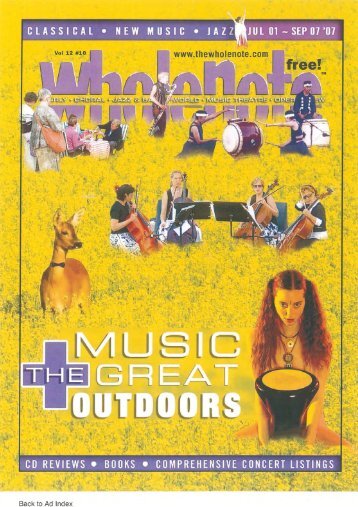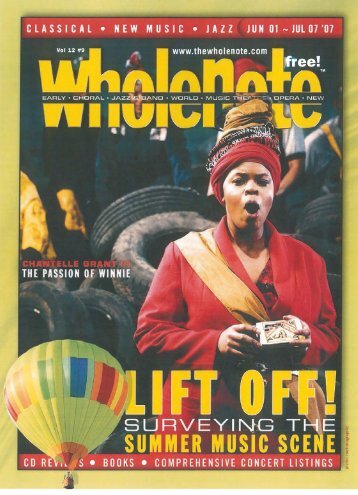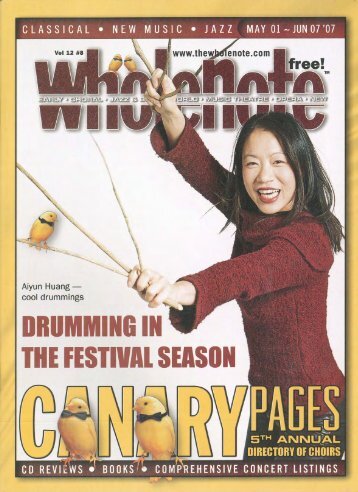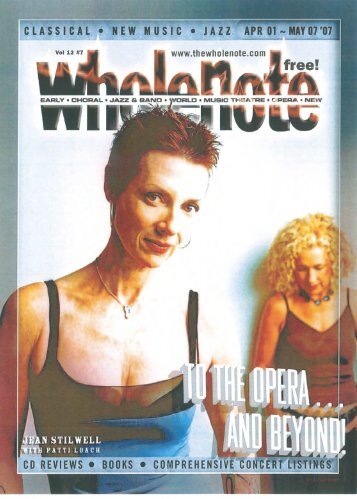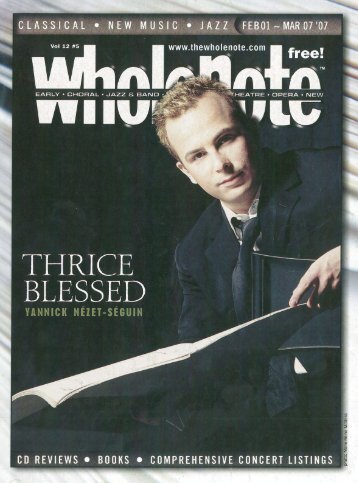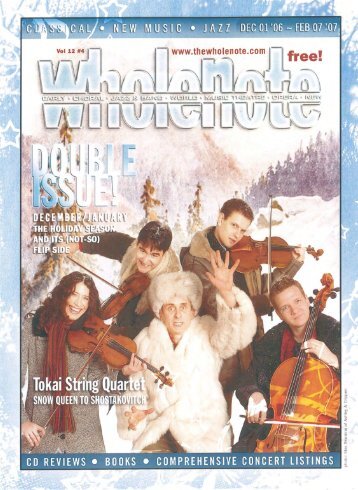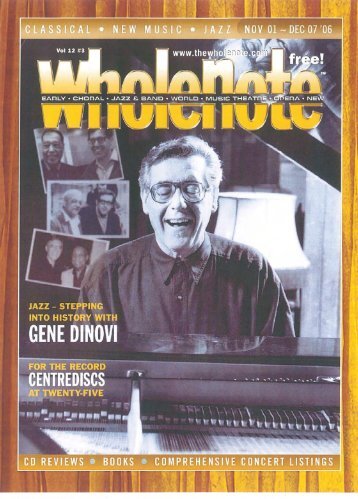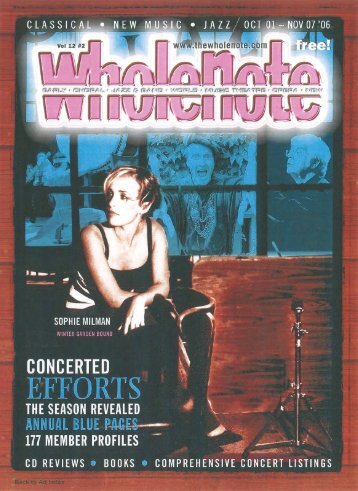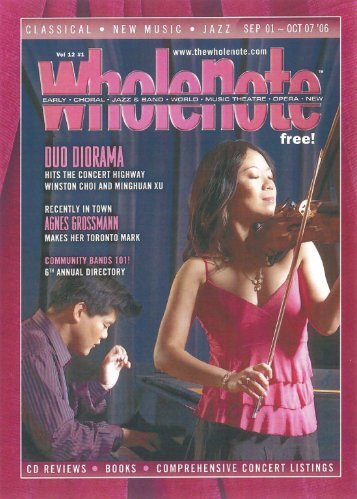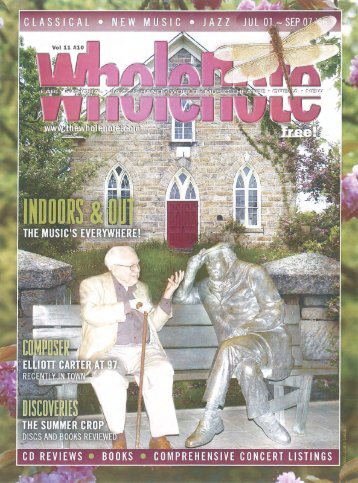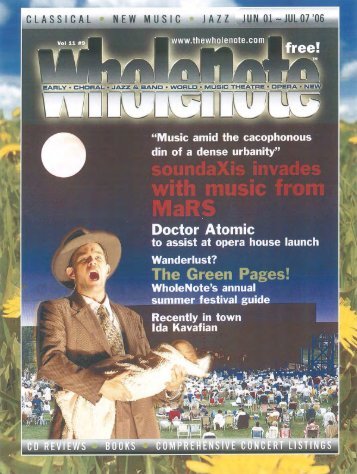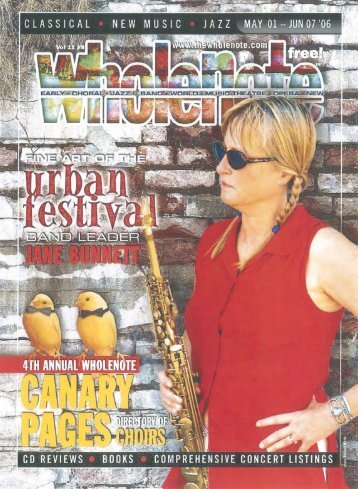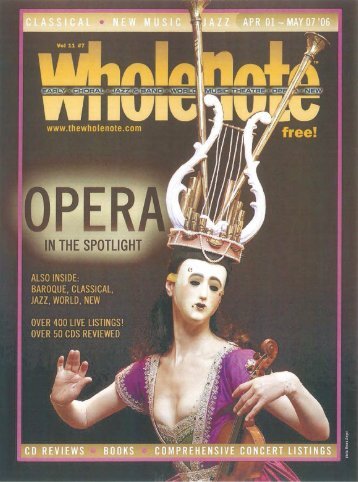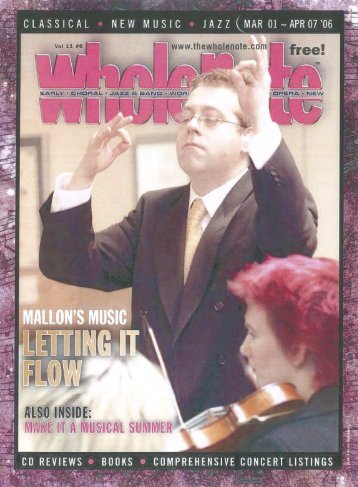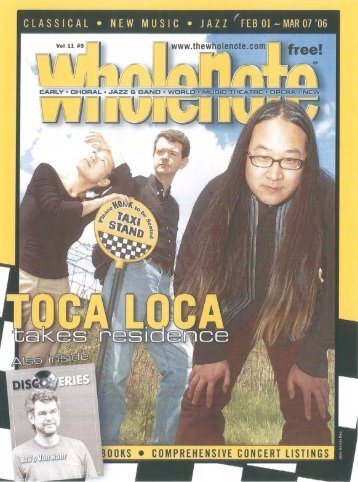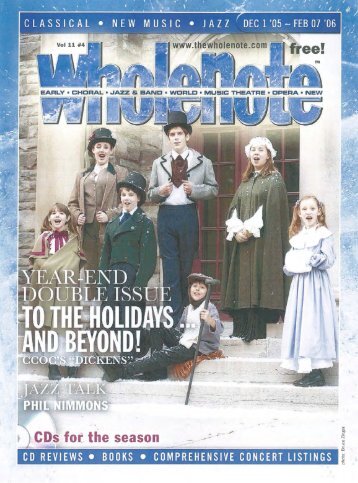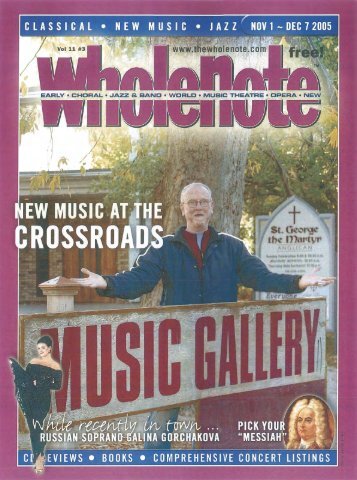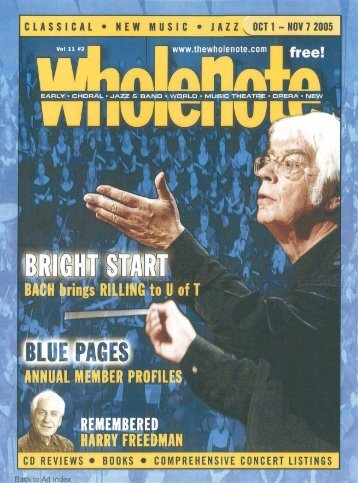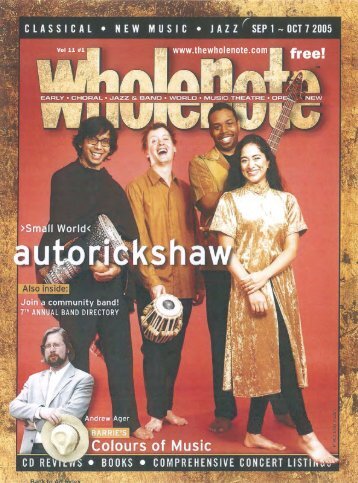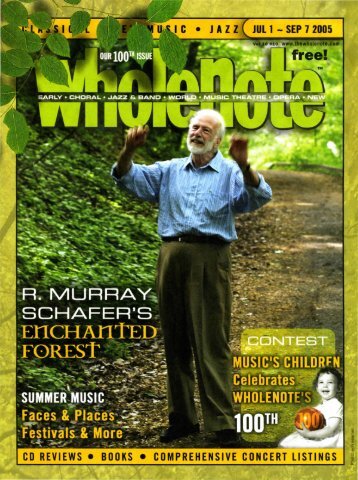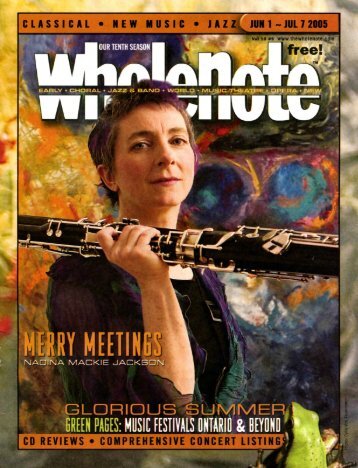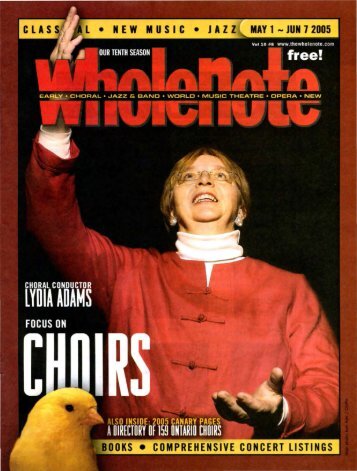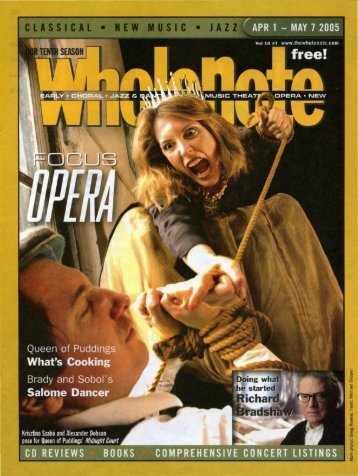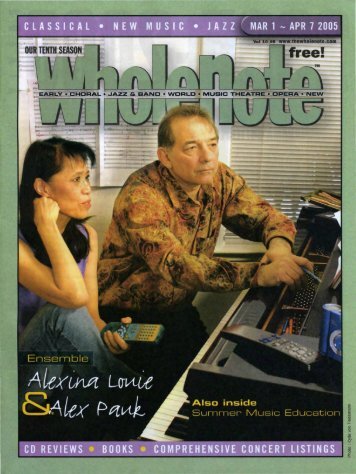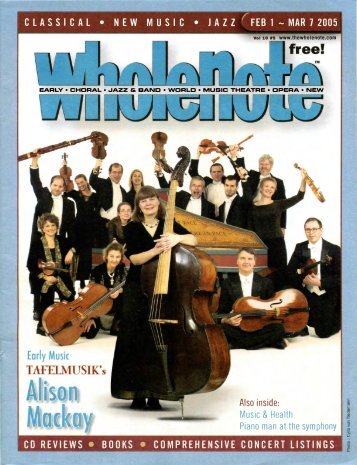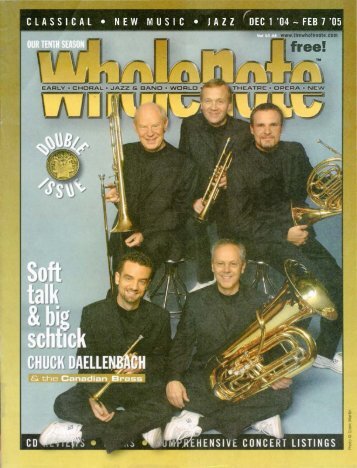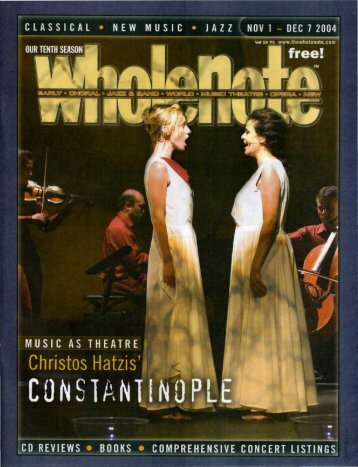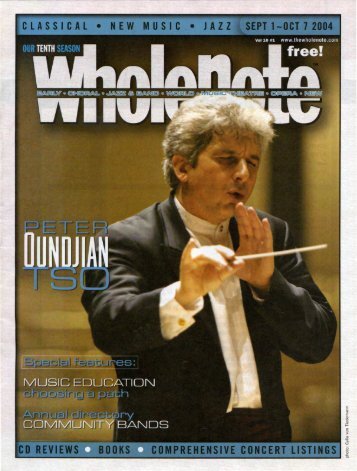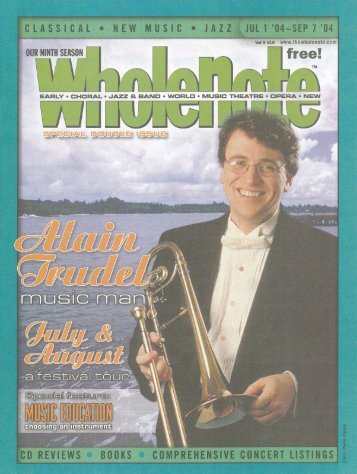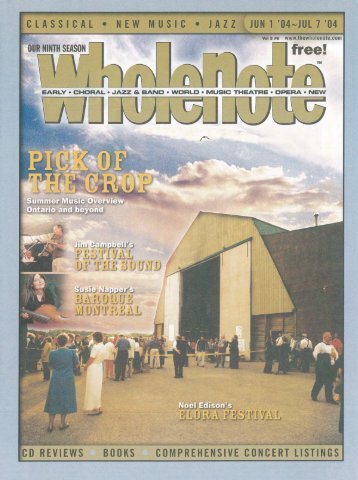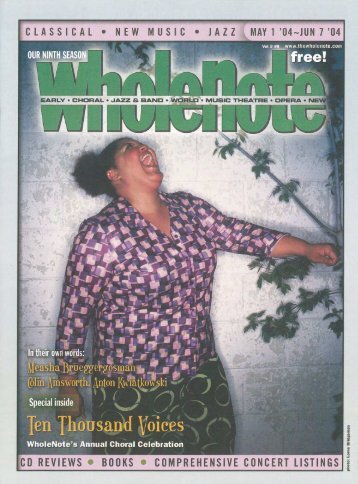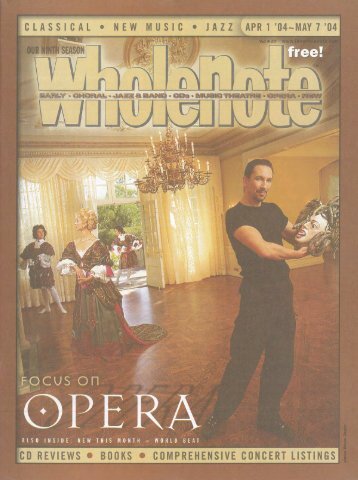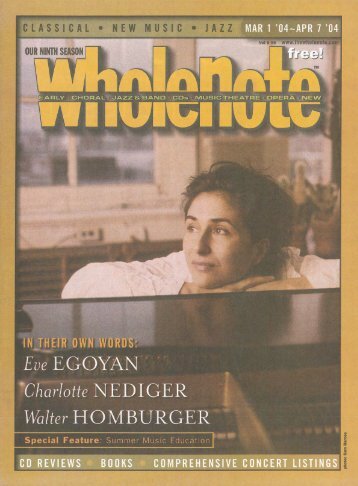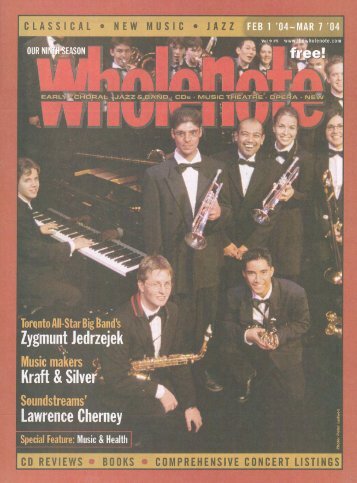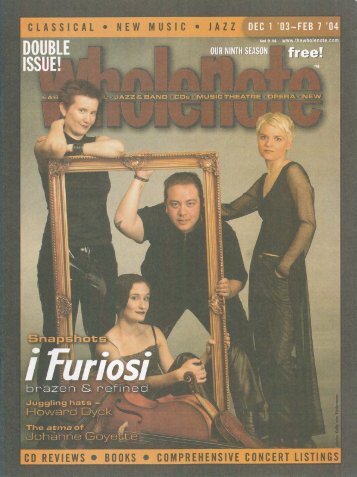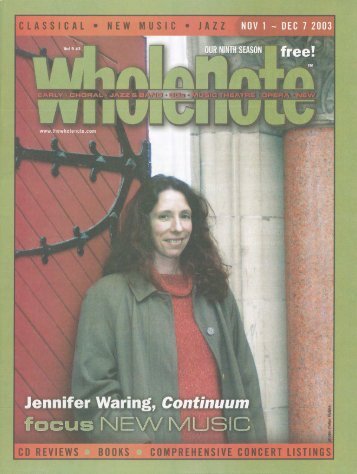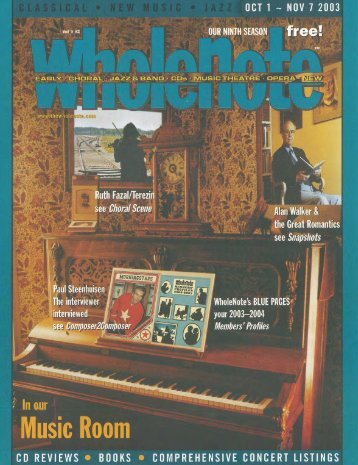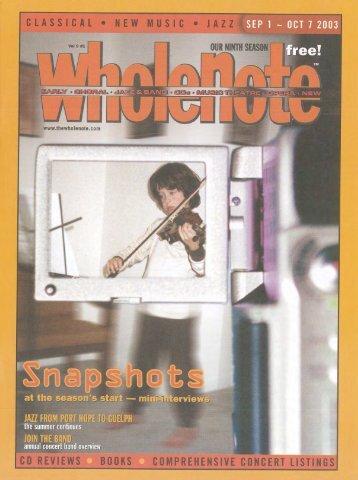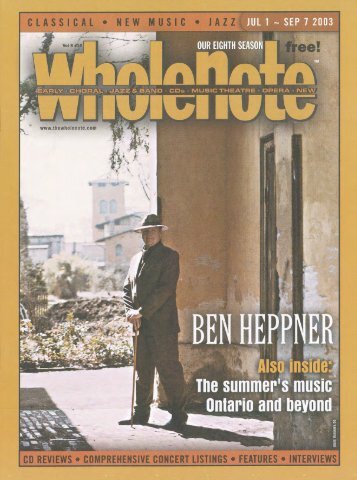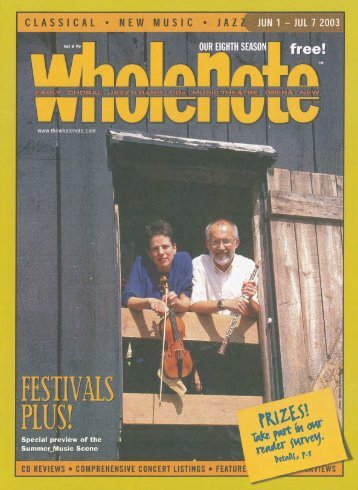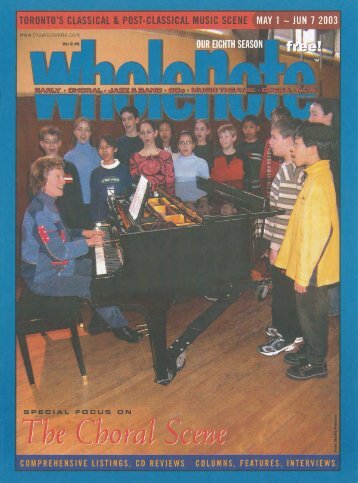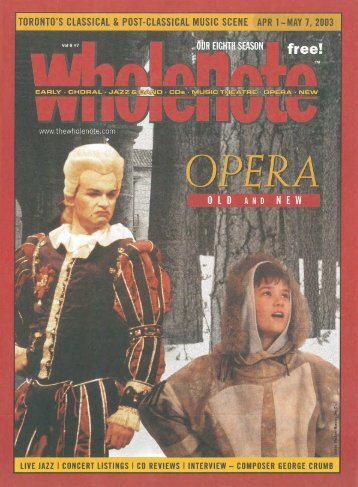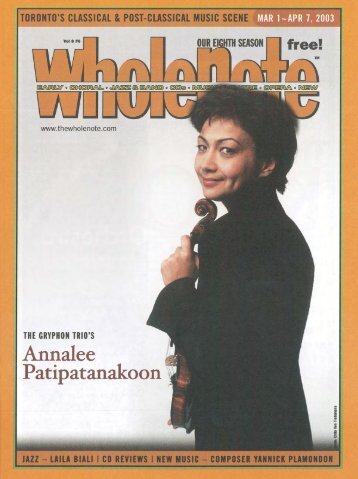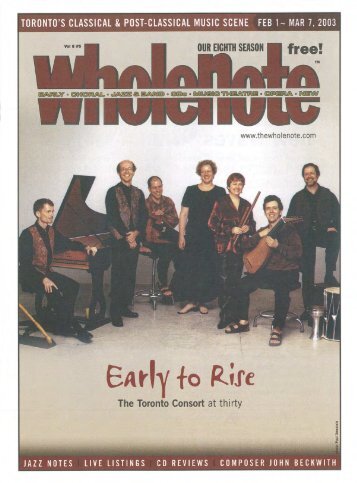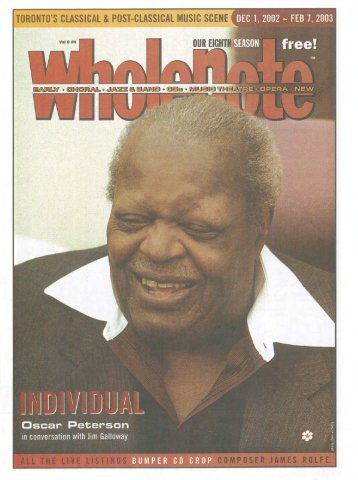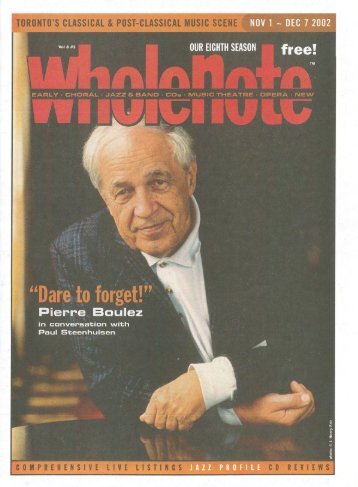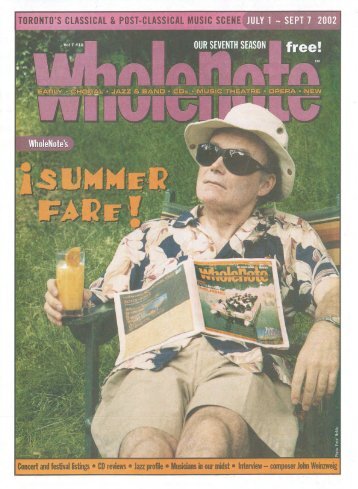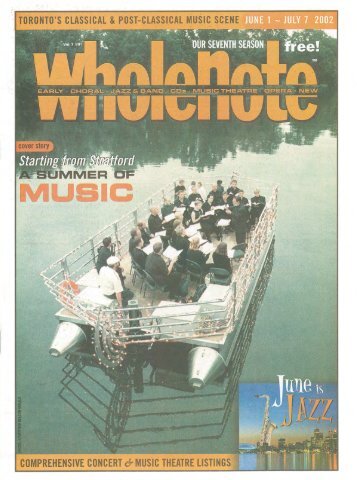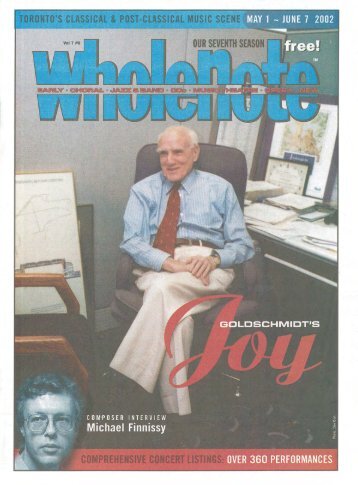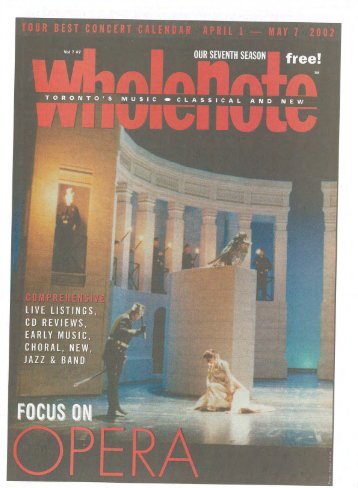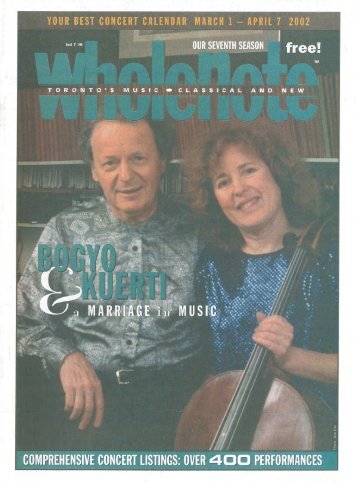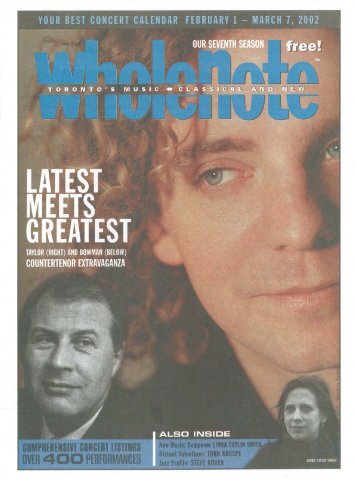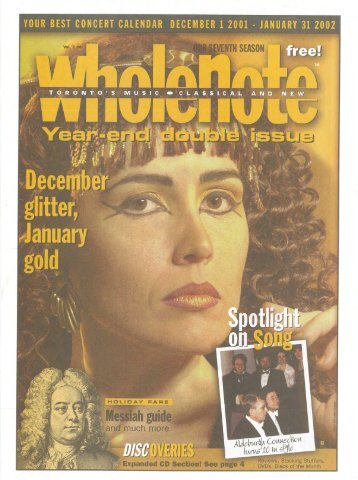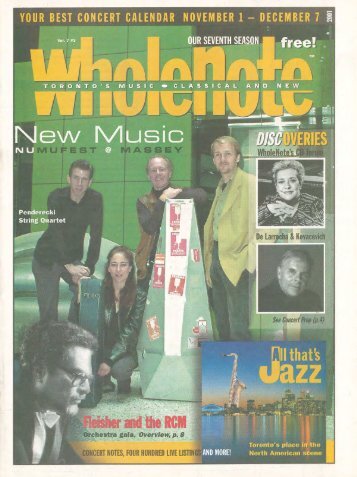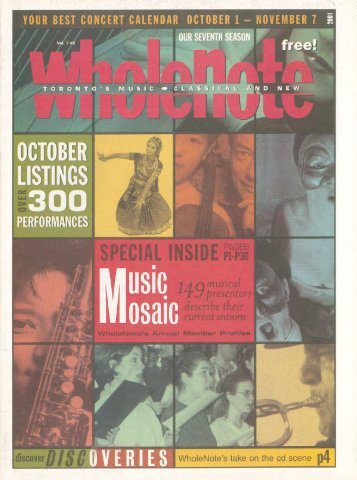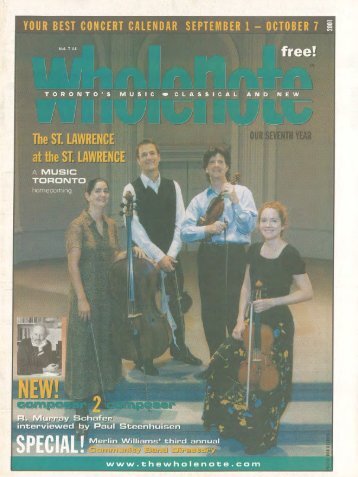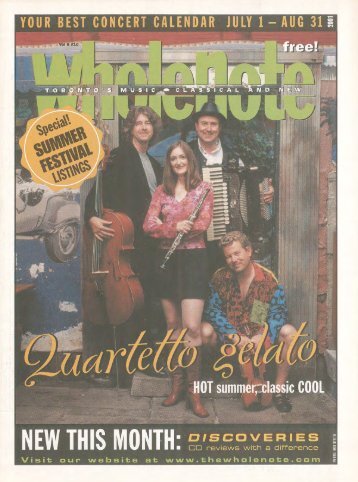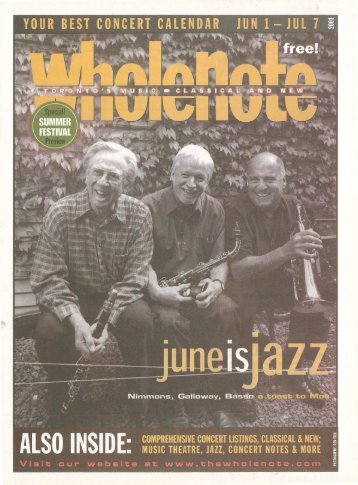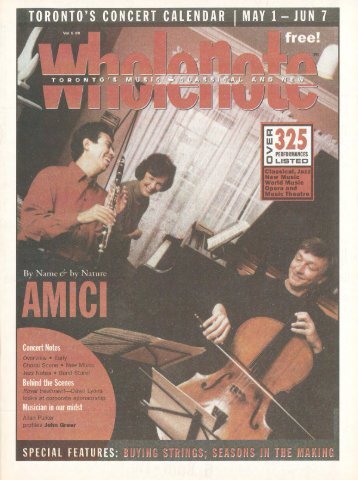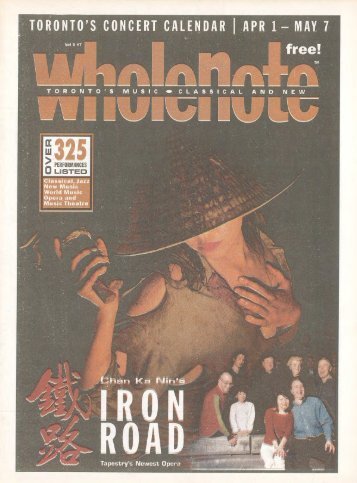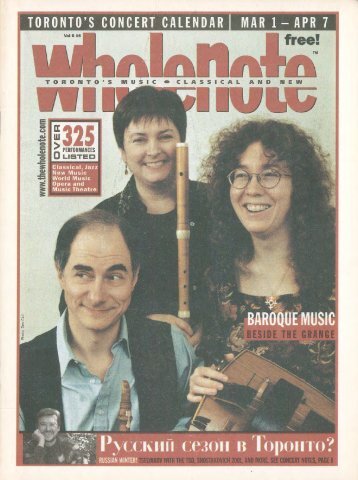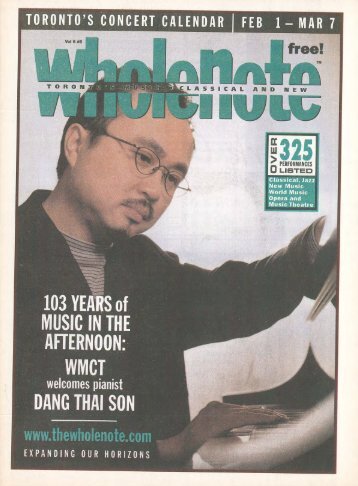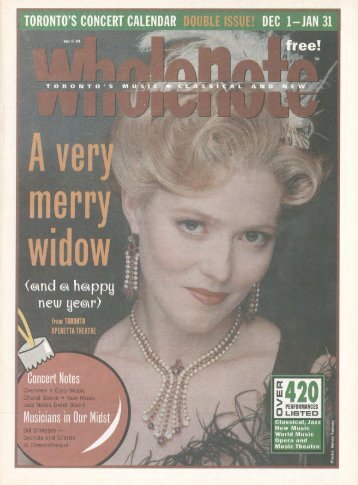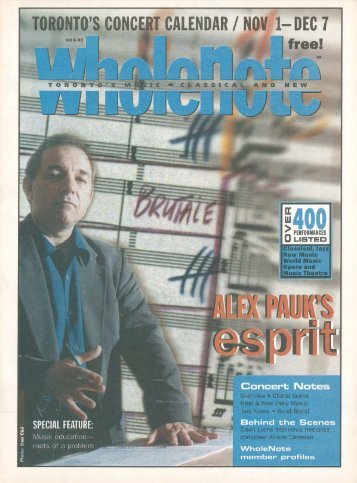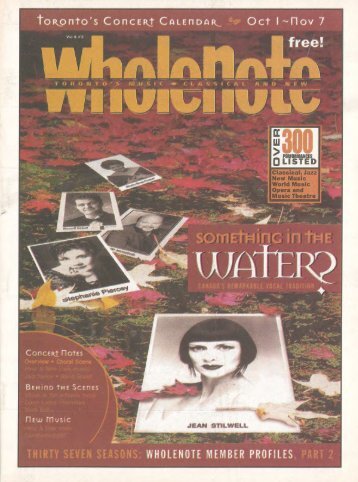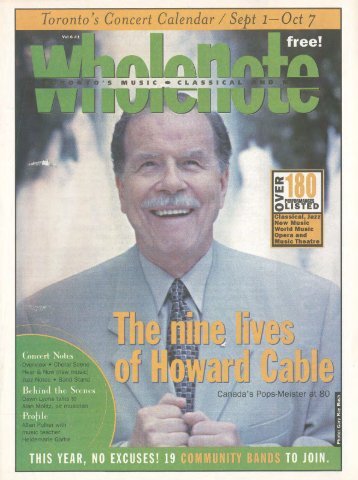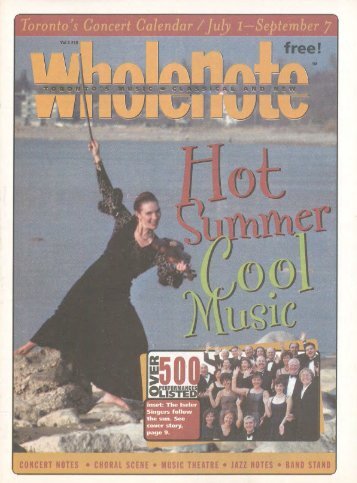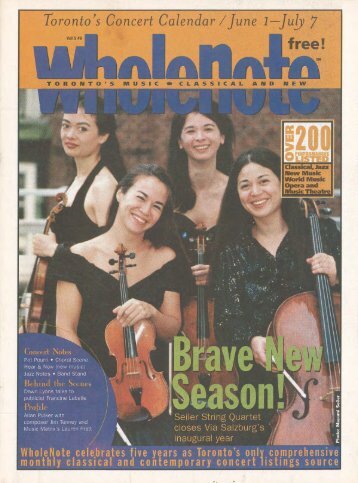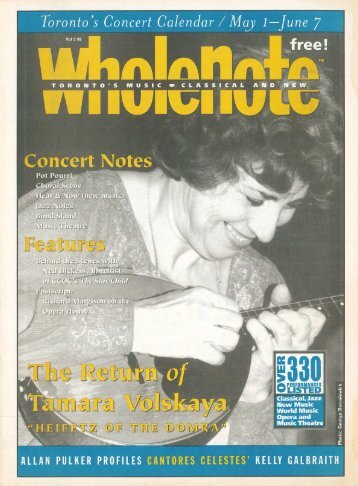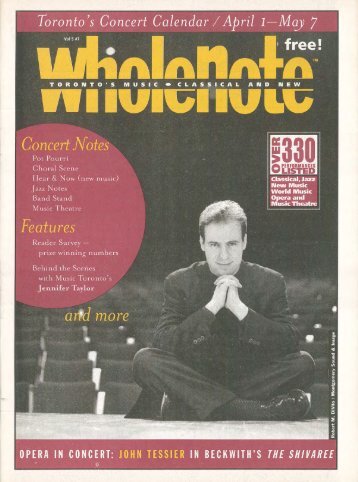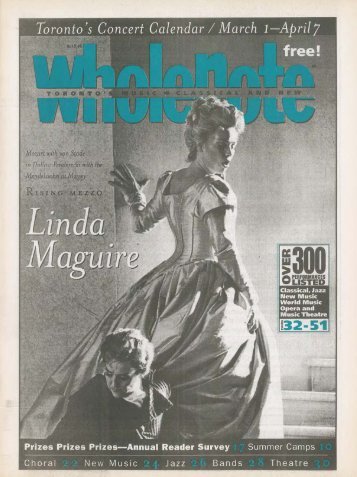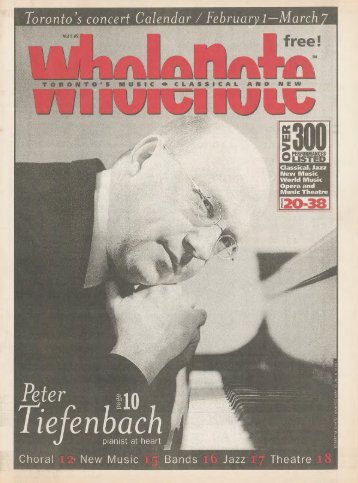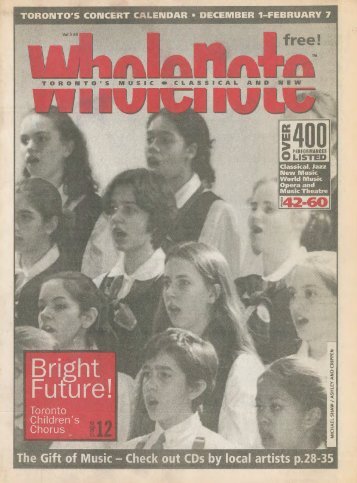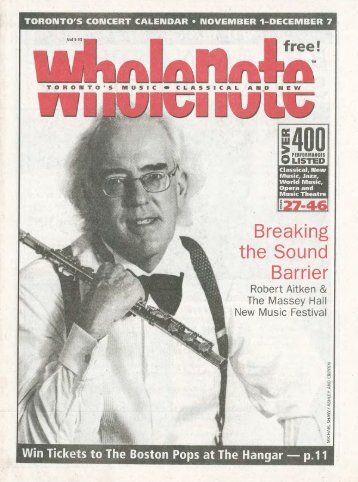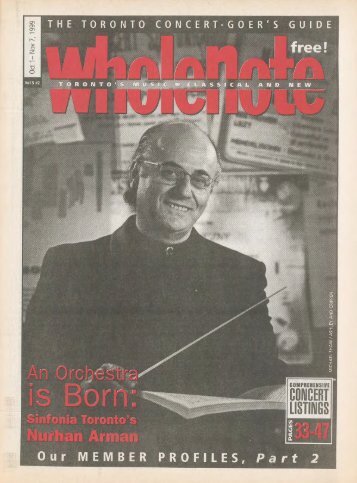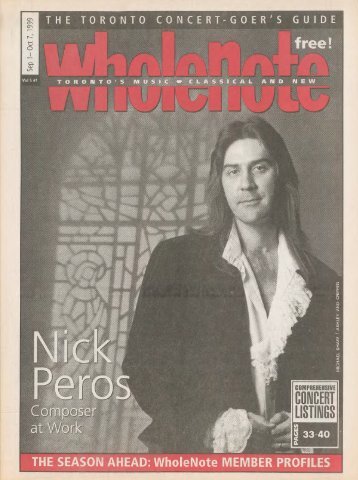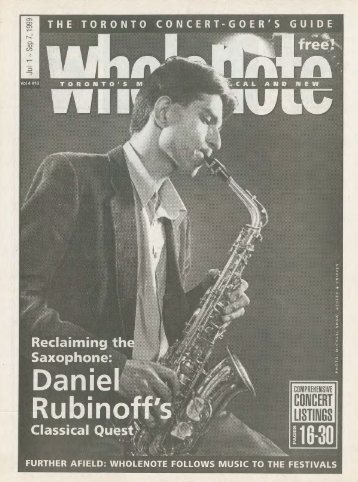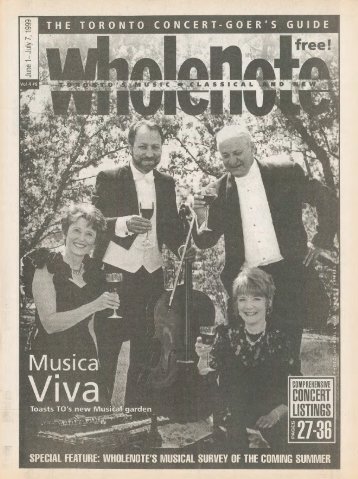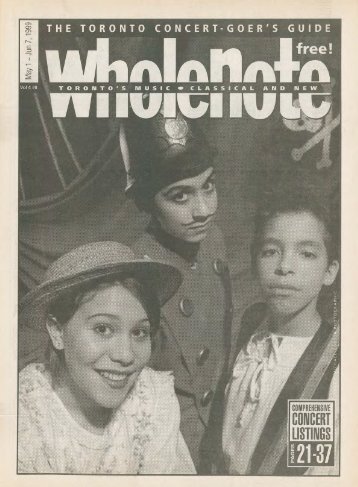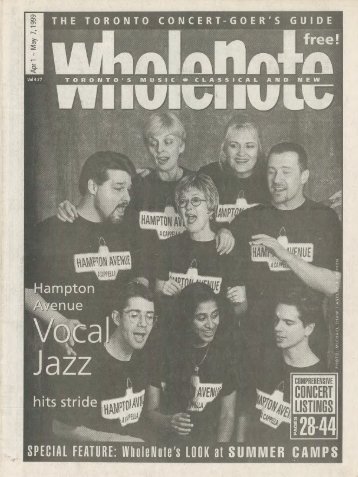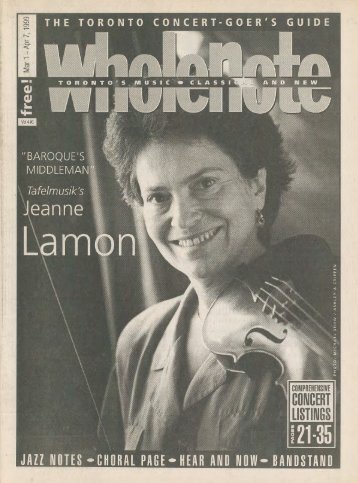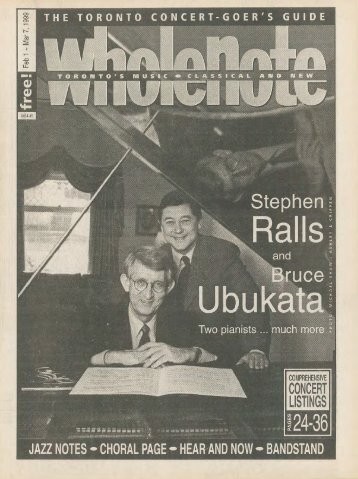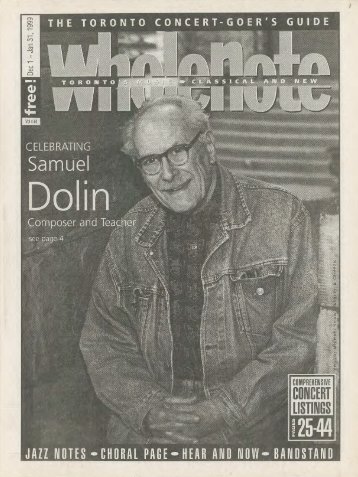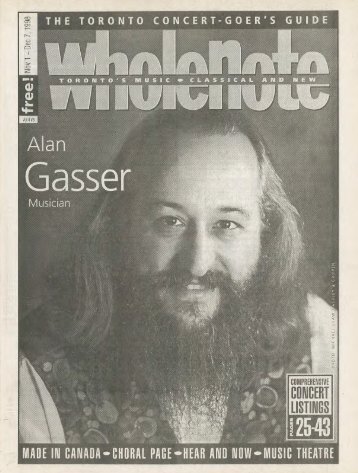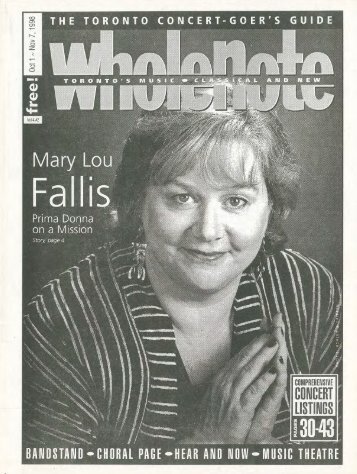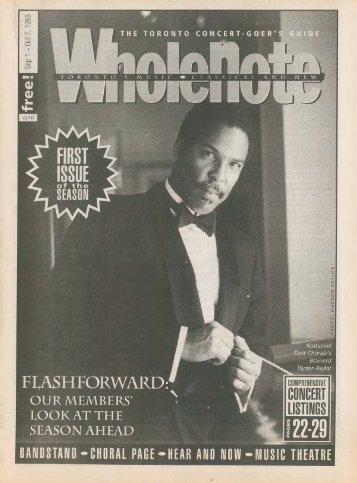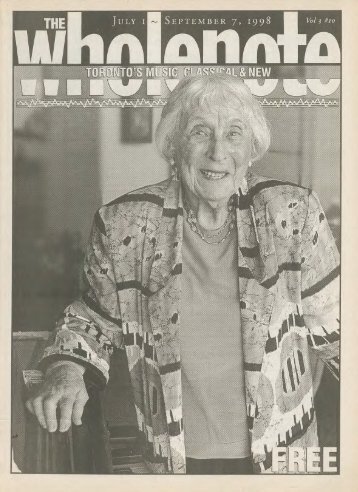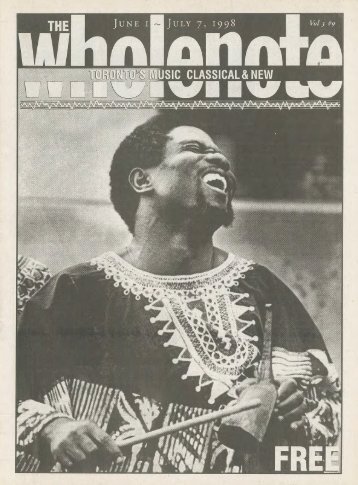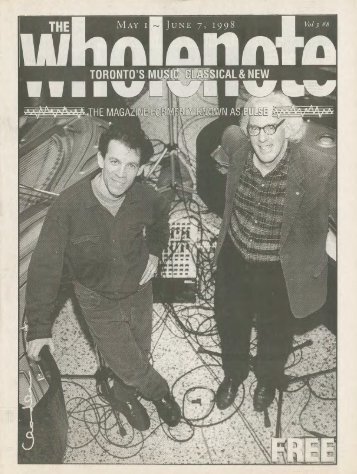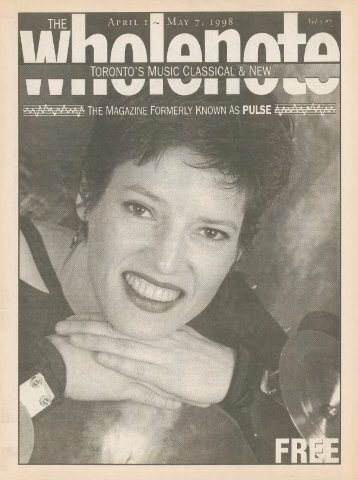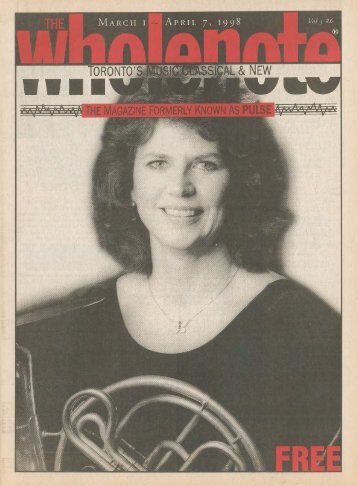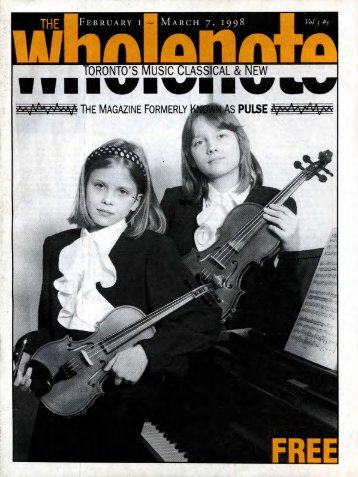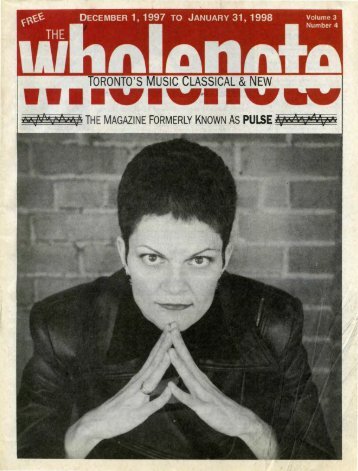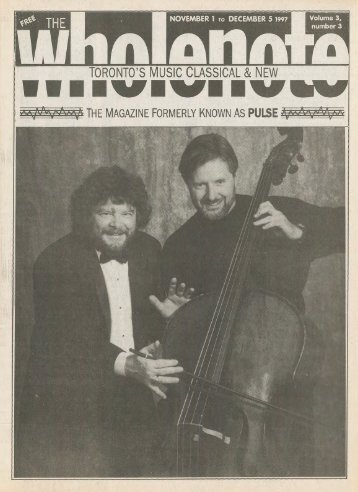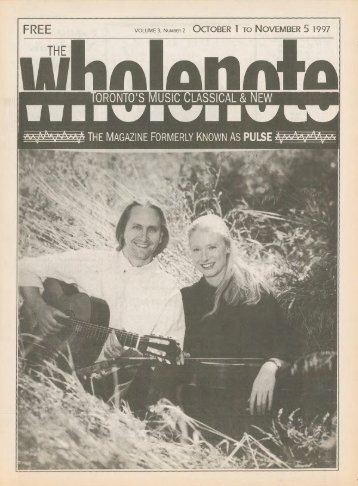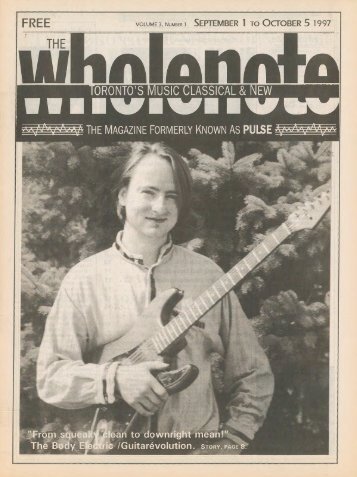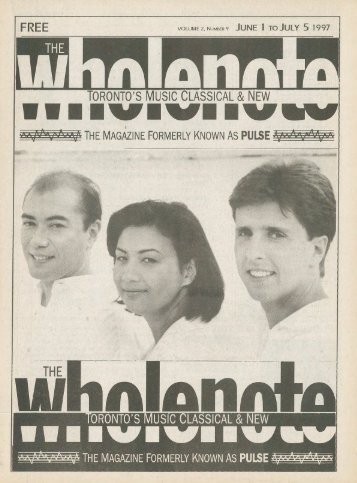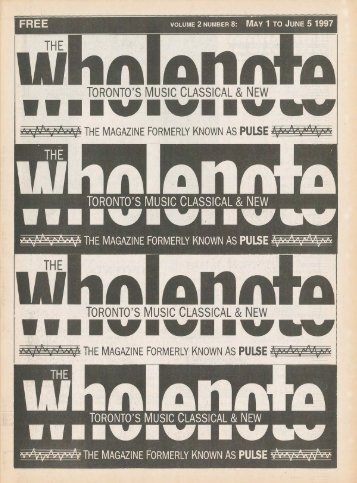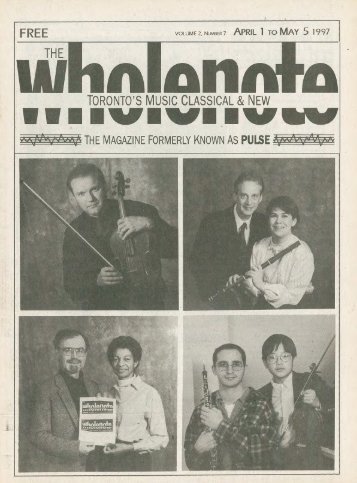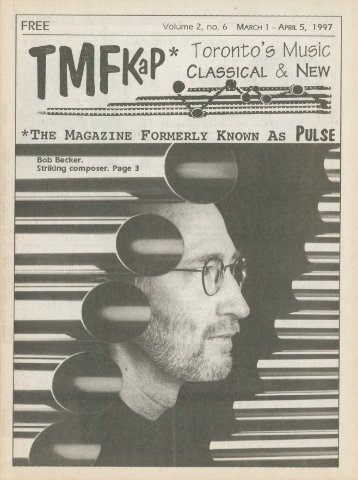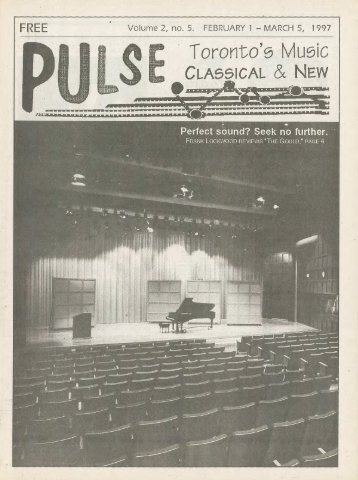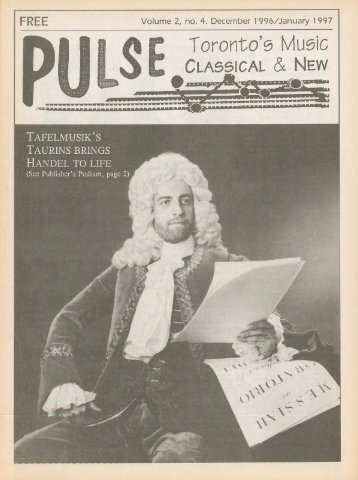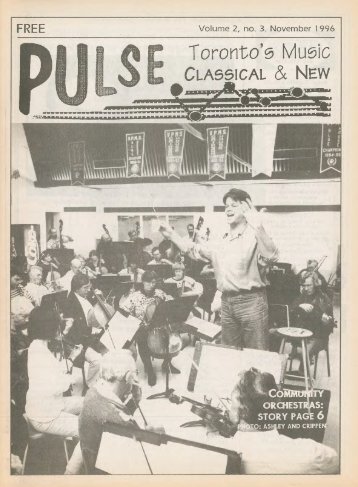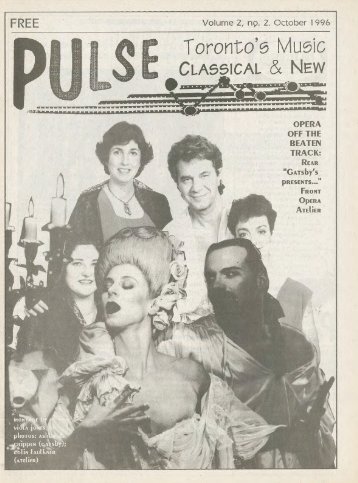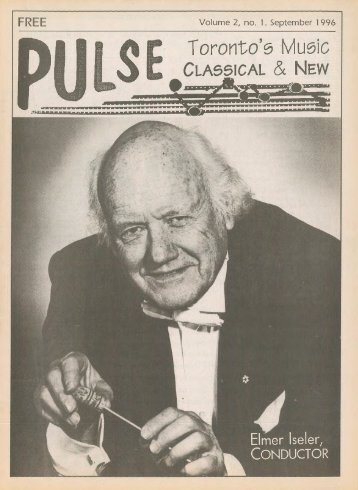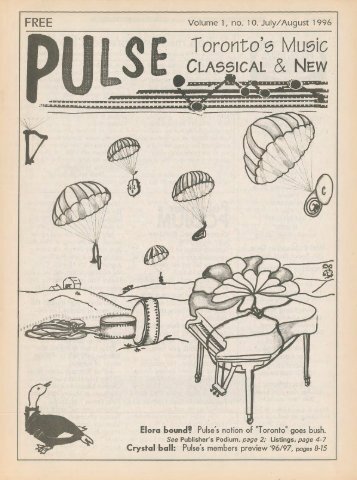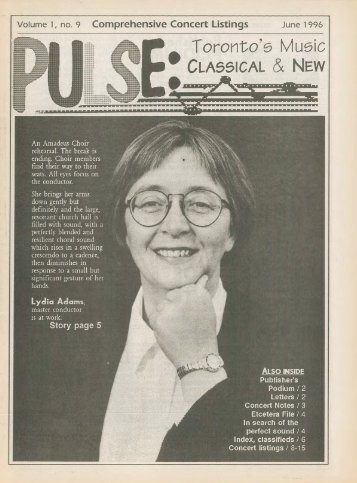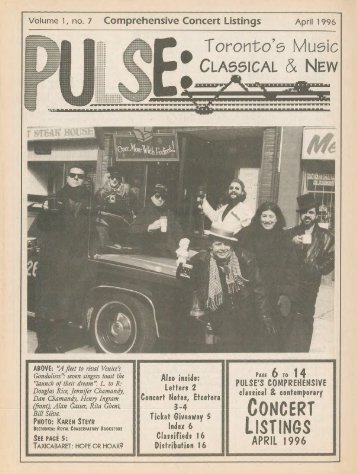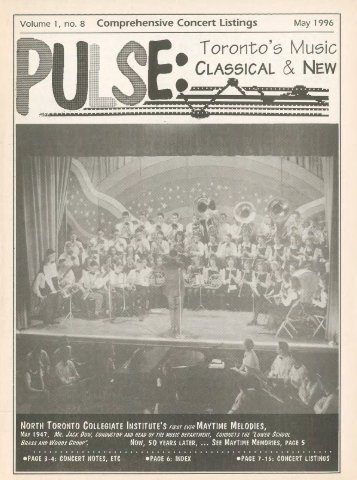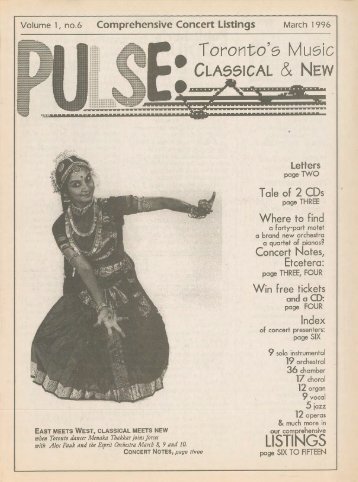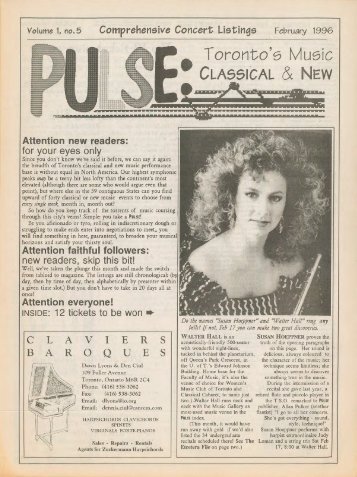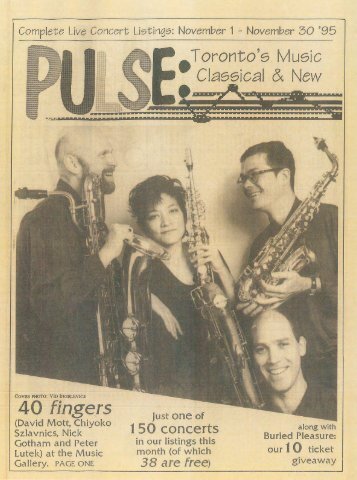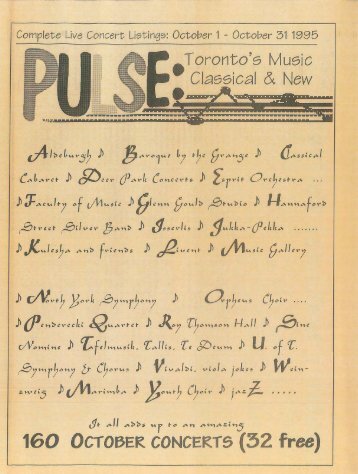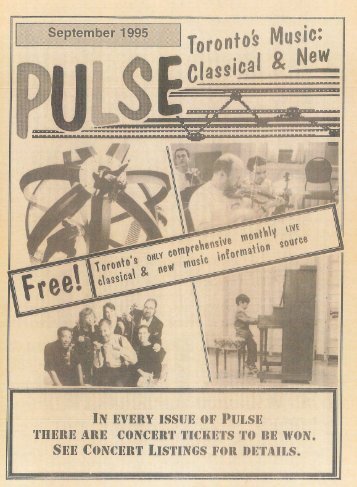Volume 21 Issue 2 - October 2015
Vol 21 No 2 is now available for your viewing pleasure, and it's a bumper crop, right at the harvest moon. First ever Canadian opera on the Four Seasons Centre main stage gets double coverage with Wende Bartley interviewing Pyramus and Thisbe composer Barbara Monk Feldman and Chris Hoile connecting with director Christopher Alden; Paul Ennis digs into the musical mind of pianist Benjamin Grosvenor, and pianist Eve Egoyan is "On the Record" in conversation with publisher David Perlman ahead of the Oct release concert for her tenth recording. And at the heart of it all the 16th edition of our annual BLUE PAGES directory of presenters profile the season now well and truly under way.
although there are two
although there are two male characters in the play – a young reporter and the now-aged professor – they only have speaking parts, not singing. I will never know how I might have felt about the CD had I not had the benefit of seeing the stage production, but my impression is that it does indeed work as an independent entity. You can sample it yourself at the website mentioned above. The things that initially drew me to Companion, the new CD from Alicia Hansen and Ben Brown (AHBB001.5 aliciahansenbenbrown.com), were the cover art by Mi’kmaq artist Jay White (draworbedrawn.com) and the fact that cellist Peggy Lee was part of the ensemble. I did not previously know White’s art but was immediately drawn in (no pun intended) to his strange hybrid of representation and abstraction. Lee is a cellist I’ve been aware of in the contemporary music context through her work with Standing Wave and other Vancouver ensembles. Although I was aware of her activity as an improviser, I was surprised to see her appear in a jazz context twice in this month’s offerings (see also Stuart Broomer’s Waxwing review in Jazz, eh?). That being said, it turns out that her role in the Hansen/Brown project is peripheral, with cello almost exclusively used as part of the overall texture and not in a solo role. Be that as it may, I’m glad I was drawn to this disc. I find Hansen’s writing (in some cases co-written with Brown) intriguing and her vocal work distinctive and enticing, at times reminiscent of Björk, especially in the haunting Outside my Window, but individual nonetheless. Hansen’s piano and keyboard work is complemented by Brown’s drumming – he’s not a timekeeper in the traditional sense but rather is heard in counterpoint with and as punctuation to Hansen’s lines. Bassist Russell Sholberg is present but unobtrusive throughout, and he adds the eeriness of a bowed saw to Little Veins. Although not a guitar-centric disc, it is guitarist David Sikula who provides the sparse, yet surprisingly rich, arrangements. The quirky In Petra adds the convincing sound of a recorder to the mix, but searching the credits I am left to conclude this is simply one of Alicia’s “keys.” Falling somewhere between (gentle) avant pop and experimental jazz, this disc is highly recommended. It has been a while since I spent any time listening to the neoclassic/baroque music of Ottorino Respighi so it was with pleasure that I found the new disc Il Tramonto featuring Isabel Bayrakdarian and Orchestre symphonique de Laval under Alain Trudel’s direction (ATMA ACD2 2732). The performances of Gli Uccelli (The Birds) with its aural aviary based on earlier renderings by 17th century composers, Trittico Botticelliano depicting paintings of the renowned artist and Antiche Arie e Danze (Ancient Airs and Dances) based on works of the Baroque are all that could be asked for, with Trudel drawing clarity and balance from his fine ensemble. My only disappointment came in the title track, and not from any flaw in the performances. Bayrakdarian is in fine voice, enunciating the Italian words translated from the poetry of Percy Bysshe Shelley with warmth and passion. And the orchestra rises to the challenges of this work which is distinctly romantic in its approach and orchestration. At times hinting at the music of Wagner – Siegfried Idyll comes to mind – the story lends itself to this lush treatment. But here is where my concern lies. The otherwise informative notes (for the instrumental pieces) are here inadequate. At first I thought it was just an awkward translation into English, but checking the original French it seemed as if the writer had not actually read the poem (which is included in Shelley’s English, Respighi’s Italian and in French). We are told that the poem “embodies the purest Romantic tradition, with its depiction of a sunset symbolizing the death of two lovers.” But Shelley clearly states “That night the youth and lady mingled/lay in love and sleep – but when the morning came/the lady found her lover dead and cold.” The remainder of the poem makes clear that she went on to live a long life mourning his loss. That notwithstanding, I have no qualms in endorsing this fine recording. One quick note in closing. September 17 saw the kick-off of the annual Small World Music Festival with a prefestival launch party featuring the Toronto debut of the big band Fanfaraï. Somewhat bombastically billed as “French/Algerian/ Moroccan jazz musicians with a passion for the Maghrebian 6/8 who begin to sing in Arabic, Berber and Turkish, dancing like the Gnawa ... Fanfaraï is a Rai UFO matured in the copper sun of North Africa breathing intercultural harmony and sensory journey into Great Happiness!” I recently received their 2013 release Tani (tournsol.net) and am sad to say that if this disc is any indication, I missed what must have been a fabulous party that night – I’m dancing in my seat as I write this! Concert Note: The Small World Music Festival continues through October 4. We welcome your feedback and invite submissions. CDs and comments should be sent to: DISCoveries, WholeNote Media Inc., The Centre for Social Innovation, 503 – 720 Bathurst St. Toronto ON M5S 2R4. We also encourage you to visit our website thewholenote.com where you can find added features including direct links to performers, composers and record labels, “buy buttons” for online shopping and additional, expanded and archival reviews. David Olds, DISCoveries Editor discoveries@thewholenote.com Charles Lloyd – Wild Man Dance Recorded live at the Jazztopad Festival in Wroclaw Poland Ocean Fanfare - “Imagine Sound Imagine Silence” Without ever completely leaving the jazz ocean they set to the edge of what modern jazz sounds like in the new millennium.” Isokoski’s latest release finds the soprano singing a dozen songs of the 19th c. by three of the finest French song composers of the time. This set is the first to present the complete organ works of Johann Kuhnau - once a St. Thomas Cantor until his friend Bach took over. 60 | Oct 1 - Nov 7, 2015 thewholenote.com
Keyed In ALEX BARAN Pianist Edison Quintana has recorded an intriguing document that surveys Mexican piano music of the 19th and 20th centuries. Admittedly, we know only a modest amount of Mexican music history and most of us would be lucky to name more than one Mexican composer. What a surprise then to discover some familiar names in the program notes and hear the marks of both European romanticism and serialism in México entre dos siglos (URTEXT JBCC243). The new world’s independence of musical evolution from trends in the old world seems much less obvious in the Mexican case. There are, for example, strong echoes of Liszt in Ricardo Castro’s Vals-capricho. Manuel Ponce’s Intermezzo No.3 evokes a languorous Chopin waltz and José Pablo Moncayo’s Tres piezas para piano conjures up works by Bartók and Satie. But, lest I suggest that Mexican composers tend to be derivative, one should note how Silvestre Revueltas’ Cancion uses strong patterns of parallel fourths in a pentatonic mode to create an air of something uniquely indigenous. And who knew that Juventino Rosas’ Sobre las olas is immediately familiar as North America’s best known carnival tune? Quintana selects a beautifully balanced program that moves through an artful variety of contrasts. He is a seasoned, mature performer and academic who breathes articulate authenticity into every piece he performs. Mexican composers are fortunate to have such a champion. I’ve always enjoyed comparing piano performances of Bach’s Goldberg Variations because one learns so much about the essence that the pianist discovers in the opening Aria and how that informs the subsequent 30 variations. Lars Vogt brings an overall light touch to his performance and a highly disciplined tempo free of overly expressive rubato and dynamics. Instead he concentrates on pulling forward the contrapuntal material with satisfying clarity. On the few occasions where he does allow for pullbacks to emphasize contrast or underline an emotional point, he does so with measured reserve and the result is very effective. His Goldberg Variations (ONDINE ODE 1273-2) is masterfully constructed with clear intent and informed by a rhythmic conviction that never wavers. The several toccata-like variations are delivered with speed and clarity at no cost to Bach’s inner voices. His performance of the closing Aria is possibly the most tender I have ever heard. A small point but one that made me smile was Vogt’s reversal of an arpeggio in the repeat of the Aria. An unexpected and lovingly cheeky moment. You should definitely add this CD to your Goldberg collection. Another variations disc is Olga Pashchenko’s Beethoven Variations (ALPHA 201) which also includes the Sonatas 19 and 20. Pashchenko plays a modern fortepiano modelled after a Viennese instrument built ca. 1818. The recording is surprisingly good. One reason for its immediate appeal is that the instrument has been prepared in such a way as to offer tonal and pitch stability so often absent in other performances. Rather than sound like a saloon upright out of a cheesy western, this fortepiano actually establishes a credible voice with an astonishing range of colours across its dynamic range. Pashchenko deserves credit for understanding its potential and mastering the technique to realize it. This is the keyboard sound Beethoven would have known before he came to play the English Broadwood grands. It would have been the voice for which he first wrote. Both sets of variations on this disc are based on original themes by Beethoven and so break with the more common practice of using material by other composers. Pashchenko treats the fugue at the end of the Prometheus Variations Op.35 rather independently from the main body of the set but her assertive playing is completely captivating through the development section where her technique truly shines. She’s equally dazzling in the Fantasia Op.77. American pianist Penelope Crawford on Beethoven Sonatas Opp.78, 81a, 90 & 101 (musica omnia MO-0510) also uses a fortepiano in her recording. This one, however, is not a modern copy but an original 1835 instrument by Viennese builder Conrad Graf. Its sound is surprisingly modern and different from that of Pashchenko’s recording. One of Beethoven’s last instruments was by this same builder, though by then Beethoven’s deafness would have prevented him from appreciating its finer qualities. Crawford’s approach to this repertoire is well-founded on her years teaching at several American institutions. Her performance credentials, too, are varied and impressive, having played much period music with ensembles dedicated to historically informed interpretations. Her program traces the evolution of Beethoven’s style from the (late) middle period sonatas to the denser, more complex later works with longer thematic ideas. She does a splendid job with increasing aggressiveness in the Opp.90 and 101 sonatas. One of her more fascinating techniques is how she uses the pedals to both mute and sustain specific passages in a tonal colour not possible on modern pianos. This is a very fine recording with special significance to those who value historical authenticity. Angela Hewitt’s recording of Beethoven Piano Sonatas (Hyperion CDA 68086) puts a pair of early works up against two considerably later utterances in the form. Hyperion produced this 2014 concert recording on a Fazioli in a Berlin church with an acoustic that offers a perfectly balanced space around the piano. One only ever hears more of the room when the music rises above forte and, even so, the intimacy of the performance is never lost. Following Hewitt on Facebook, one stays in touch with her travels, rehearsals, recording sessions and performances. It makes listening to her CDs rather like going to a friend’s home for a private recital. She is a fastidious player when it comes to articulation and her phrasings are masterful in both the Op.2 and Op.10 sonatas where echoes of classical structure are quite pronounced. Hewitt delivers everything from the crispest staccatos to the gentlest lifts in defining the inner voices that Beethoven weaves throughout. The Adagio of the C Minor Sonata is especially engaging because Hewitt understands how Beethoven wants to unsettle its pretty little thematic idea. She does this beautifully. Hewitt’s approach to the A-Flat Major Sonata Op.110 second movement is a good deal less frenetic than many pianists often take but never lacks for convincing energy. The final movement is, however, the most arresting. Here Hewitt creates a profound air of mystery around the extended Adagio that sustains the listener for about eight minutes until she breaks into the closing fugue. A terrific disc. Concert note: Angela Hewitt performs work by Scarlatti, Bach, Beethoven, Albeniz and De Falla in Kingston at the Isabel Bader Centre for the Performing Arts on October 11. Pianist Andras Schiff has taken an historic approach to Franz Schubert (ECM New Series 2425/26 481 1572) and documents a wide variety of the composer’s works on a fortepiano. He deliberately begins his notes with an intriguing “Confessions of a Convert” chapter that lays out his rationale and passion for this choice. Using his own instrument, built by Franz Brodmann in Vienna ca.1820, Schiff launches into repertoire most of us have only ever heard on a modern piano. Opening the 2-CD set with Ungarische Melodie in h-moll D817, Schiff cleverly gives his zither-like instrument a culturally Eastern selection that gets our immediate attention. Small action clicks and an thewholenote.com Oct 1 - Nov 7, 2015 | 61
- Page 1 and 2:
PRICELESS! Vol 21 No 2 OCTOBER 1 -
- Page 3:
KOERNER HALL IS: “ A beautiful sp
- Page 6 and 7:
FOR OPENERS | DAVID PERLMAN And It
- Page 8 and 9:
ERIN RILEY On the Record A Ground F
- Page 10 and 11:
Facing the Darkness Barbara Monk Fe
- Page 12 and 13:
Beat by Beat | Classical & Beyond G
- Page 14 and 15:
lapping water and sparkling rivulet
- Page 16 and 17:
Glionna Mansell Corporation Present
- Page 18 and 19:
Beat by Beat | In with the New More
- Page 20 and 21:
weekend, Smith says: “It will giv
- Page 22 and 23:
under Soviet and Nazi regimes, in 1
- Page 24 and 25:
another season with rehearsals in P
- Page 26 and 27:
fighting is his beloved disguised a
- Page 28 and 29:
Nine Sparrows Arts Foundation & Yor
- Page 30 and 31:
Lydia Adams, Conductor & Artistic D
- Page 32 and 33:
Beat by Beat | Early Music Where We
- Page 34 and 35:
Beat by Beat | Jazz Stories Remembe
- Page 36 and 37:
BLUE PAGES 2015/16 16th ANNUAL DIRE
- Page 38 and 39: BLUE PAGES 2015/16 ●Arraymusic Ar
- Page 40 and 41: BLUE PAGES 2015/16 an international
- Page 42 and 43: BLUE PAGES 2015/16 Annual auditions
- Page 44 and 45: BLUE PAGES 2015/16 organs in the wo
- Page 46 and 47: BLUE PAGES 2015/16 in that capacity
- Page 48 and 49: BLUE PAGES 2015/16 their vocal skil
- Page 50 and 51: BLUE PAGES 2015/16 communities of p
- Page 52 and 53: BLUE PAGES 2015/16 Opera York conti
- Page 54 and 55: BLUE PAGES 2015/16 performers at ev
- Page 56 and 57: BLUE PAGES 2015/16 ● Syrinx Conce
- Page 58 and 59: BLUE PAGES 2015/16 late renaissance
- Page 60 and 61: BLUE PAGES 2015/16 season will end
- Page 62 and 63: DON’T EVER STOP MUSIC IS FOR LIFE
- Page 64 and 65: The WholeNote listings are arranged
- Page 66 and 67: 24, 29, Nov. 1, 4); James Westman,
- Page 68 and 69: A. Concerts in the GTA and Pantayo.
- Page 70 and 71: Vaughan Williams: A Sea Symphony. T
- Page 72 and 73: ●●2:00: Canadian Opera Company.
- Page 74 and 75: ; (under 30). 1:15: Music & T
- Page 76 and 77: B. Concerts Beyond the GTA IN THIS
- Page 78 and 79: Rückert Lieder; Purcell: Dido and
- Page 80 and 81: Beat by Beat | Mainly Clubs, Mostly
- Page 82 and 83: C. In the Clubs (Mostly Jazz) D. Th
- Page 84 and 85: D. The ETCeteras Classified Adverti
- Page 86 and 87: continued from page 9 On the Record
- Page 90 and 91: intimate voice make this recording
- Page 92 and 93: VOCAL Rossini - Aureliano in Palmir
- Page 94 and 95: octaves higher. A sense of wide-ope
- Page 96 and 97: Wei and pianist Angela Park, perfor
- Page 98 and 99: triumphs and instructive pleasures
- Page 100 and 101: sympathetic ending. As for the cons
- Page 102 and 103: Old Wine, New Bottles Fine Old Reco
- Page 104: LOVE THE LIVE EXPERIENCE DON’T MI
Inappropriate
Loading...
Mail this publication
Loading...
Embed
Loading...

